The Samsung Galaxy S10 Snapdragon & Exynos Review Almost Perfect Yet So Flawed AnandTech

Forbidden
You don't have permission to access /api.php
| on this server. | |||
Additionally, a 403 Forbidden | Additionally, a 403 Forbidden+ | ||
() | |||
| 8/ | |||
| /5 | GB | ||
| | |||
| - | |||
12MP 1.4µm (Embedded D), | |||
| - | |||
| - | |||
Dual /Hybrid SIM/microSD (Certain models) | |||
| ax | |||
| USB Type-C | |||
| 6/12: 8/: | 12: 5: | 12: 5: |
The big changes of the new
Additionally, a 403 Forbidden series can be summed up into three main aspects: a new design with a new screen, new internal hardware with the latest-generation silicon,a new camera setup consisting of three camera modules.
On the internal hardware side, brand-new s from Qualcomm S.lsi promise generational jumps in . These latest s benefit from newer manufacturing nodes, upgrades to the ss,introducing new dedicated blocks for neural network inferencing in the form of a new a new .
For the cameras, the
Additionally, a 403 Forbidden+ incorporates much improved processing as well as support for high dynamic range image capture. And this time around doesn't include just one or two camera modules, but instead the company has moved up to three rear cameras for their flagship smartphone. Altogether the phone now uses a trifecta of wide angle, regular main,telephoto modules.
The
Additionally, a 403 Forbidden mainline series comes in 3 models: the
, the regularAdditionally, a 403 Forbidden,the up-sized
Additionally, a 403 Forbidden+. With offering so many phone variations – 6 in all – we've decided to dedicate our coverage to just a single model. To that end, out of popular demand following last year’s , we've opted to focus on the headliner
Additionally, a 403 Forbidden+, taking a look at 's big flagshipthe versions that it's comprised of.
Diving right into the detailed specifications, the situation was quite a controversial topic for in2019, with the LSI (S.lsi) -powered variant of the Galaxy S9 delivering underwhelming
HiSilicon launched their nearly six months ago, taking the lead in delivering the first Android built on ’s 7nm manufacturing node. Thanks to its process advantage, HiSilicon was able to deliver significant gains, which we've seen first-hand in . On paper then, the is quite similar to the HiSilicon chip in terms of designmanufacturing technologies,our pointed out to similar great efficiency gains.
We’ll come back to the chipsets in further detail over the next few pages, but suffice it to say, the new chipsets are going to play a critical role in the new phoneswill dictate a lot of the user experience of this new generation.
Moving on, let's talk about storage. The base configurations for the
Additionally, a 403 ForbiddenS10+ come with of D, while the S10e starts at 6GB, so no phone at any tier is starting short on . What is also great is that has phased out the 64GB storage tier for this generation, meaning that all S10 models come with at least 12 of storage. I think this is a pretty important aspect of the value proposition is making with the
Additionally, a 403 Forbidden’s base configurations, as it contrasts very favorably against Apple's stingy storage tiers, which sees all of its iPhone configurations start at just 64GB, with the higher-tier models costing an extra $150.
Going up to higher capacity configurations, the S10e also comes in a configuration that includes an extra 2GB of D, all of which tacks another $100 on to the price tag. Meanwhile the S10S10+ can jump from 12 of storage to 5 for an extra $250. And finally at the top, the S10+ is available in an ultra-premium configuration that sports of D, 1TB of storage,a ceramic back, for which is charging a $600 premium over the base configuration.
Another notable change in internal specifications from generation to generation has been the increased battery capacities. The new
Additionally, a 403 Forbidden comes advertised with a new 3400mAh battery while the S10+ claims a 4100mAh unit. I say "advertised" here because is being a bit misleading with their numbers; for the new phones ’s has shifted from listing the design capacity of the batteries to their typical capacity, which ines the numbers some.
Sticking with the more traditional design capacity then, the
Additionally, a 403 ForbiddenS10+ would be rated for 3300mAh4000mAh respectively. Which compared to 's last-generation phones, is still a 10%14.2% increase respectively over the Galaxy S9S9+. In practice, the nominal capacity (actual usable cycle capacity) for one of my S10+ units shows up as 3891mAh, which as it happens is higher than even the 3747mAh showcased on my Note9.
Along with the capacity changes, seems to have also changed their battery chemistry or charging behaviour, as the PMIC is now programmed to reduce its charge capacityvoltage at 300 cycles instead of 200 cycles. Similarly, the degradation curve appears to have been delayed,it now reaches a lower 90% of the battery's design capacity after 700 cycles instead of 300. The degradation curves had been rather consistent for a few generations, so it’s interesting to see such a big change in the S10,it's something to keep an eye on in the next year or two of usage.
On the back of the phone we have the new horizontal camera layout. The, with the inclusion of three camera modules, the S10 marks the first time has ever included a wide-angle module in their Galaxy S flagships. After many years of this being an LG-only feature, we suddenly have 3 major vendors all offering a trifecta of regular angle, wide angletelephoto camera modules.
Relative to the S9, the maintelephoto modules in the S10 haven't changed in terms of their official specifications: they are still 12MP sensors, one with a f/2.4 zoom / 45° FoV lens1µm pixel pitch sensor, the other with ’s dual-aperture f/1.5 or f/2.4 main module with 77° FoVa 1.4µm dual pixel PDAF sensor. It’s to be noted that the S10 adopts new sensors for both these modules, even though their specifications on paper remain seemingly the same as on the S9. Added to the duo is the new 16MP f/2.2 1µm pixel pitch 123° wide angle unit, which gives the new
Additionally, a 403 Forbidden a new perspective on the world.
Switching over from internal parts to external features, let’s start with the back of the phone. One interesting thing about the new S10 series right off the bat is their colour scheme. The S10 pictured above is actually the “Prism Black” version, even though it’s glistening in blueish hues. In absence of direct light it does look like a very dark blue,if there’s any amount of light it has an iridescent sheen to it. Unfortunately it’s still pretty much a fingerprint magnet,this may be why chose to sample the Pearl White variants to most media. Personally, I wish would try out chemically-etched frosted glass finishes, such as those found on the OnePlus 6,or Pixel 3, as these are in my opinion the best implementations of glass backs.
Another change of note on the new S10 is that the camera setup has gone horizontal – like on the Note9 –that the rear fingerprint sensor has disappeared. Qualcomm’s ultrasonic fingerprint sensor has been in the news for a couple of years now, but the S10 is the very first device to actually employ it. The verdict from me is that it's a bit of a mixed bag. The positive thing about the new ultrasonic unit (as opposed to optical units) is that the device doesn’t need to have its screen on to scan your fingerprint. Unfortunately beyond that I’m having a hard time justifying the new sensor compared to other optical implementations.
The core issue here is simply the unlock speed – it’s takes two to three times longer than what the optical sensors on the Mate 20 Pro orcan achieve. The speed doesn’t seem to be an inherent issue with the sensor itself, as the scanning period isn’t terribly long (still quite slower than an optical sensor), but it takes quite a bit of time for the phone to actually unlock after the fact. Here I have to wonder if the is actually asleep the whole time,the fingerprint module only wakes it up after having successfully scanned or detected a scan attempt.
It’s to be noted that I tested this with the latest firmwareI didn’t have any issues other reviewers initially described – I can treat it as a usual capacitive or optical sensor, including things like pressing hardkeeping it pressed to unlock. Accuracy has been greatthe only instance of failed unlocks has been when I didn’t hold my finger on the sensor for long enough, again coming back to the issue of its slowness. I have to note that I found the unit to be ever so slightly faster at unlocking, it’s possible that it has newer FP firmware than what's on the unit (US unlocked).
One thing that I very much miss on the
Additionally, a 403 Forbidden that I’ve come to love on the S8S9 series is the pressure sensitive home button. I wish at least would mimic the haptics with the fingerprint sensor.
Turning the device to the front, we come to see the
Additionally, a 403 Forbidden’s most polarising feature: the full-screen display with its camera cut-outs. The new display uses a biggerwider aspect ratio, now going nearly edge-to-edge, top-to-bottom on the phone. The catch with such designs is that it begs the question of what to do with your usual front sensorcameras. last November first talked about the new Infinity displays,the S10 is an implementation of the Infinity O variant, with a hole-punch cutout.
Now opted to configure the
Additionally, a 403 Forbidden+ with two front-facing cameras: one primary module, which is the same as on the regular S10,one additional optical depth sensor for improved selfie portrait shots. The tradeoff with having two cameras is that you have to choose how to make space for them, either using two holes in the front, or as chose, a pill-shaped cut-out with both cameras side-by-side. What is actually interesting,this is visible in sunlight, is that this actually isn’t a pill-shape cut-out at all, but rather two circular cut-outs with a pill-shaped cover just underneath the display glass, above the AMOLED panel. I haven’t seen anybody do a display teardown on the
Additionally, a 403 Forbidden+ as of yet, but it would be interesting to see if there’s indeed just two holes on the panel with still some sort of covered active area in-between.
The proximity sensor as well as the ambient light sensor have been hidden underneath the screen to the bottom-left of the camera cut-outs. One thing that’s missing from the S10 series – having been dropped by – is the notification light. Unfortunately at this point in time there’s no substitute for it,if you aren’t using ambient display notifications, you simply will not see that you have any notifications. says that this is something that will be addressed in a software update: The plan is that there will be an animation around the camera cut-out serving as a notification light, but this has been delayed for some reason. I also have to wonder what the battery impact of such an implementation would be, as one would have to power on the DDIC just to show such a little light. In any case it is big step backwards in terms of usabilityusefulness. I hope the software update addresses this,that in the future we might have something like a true LED shining from underneath the screen, if it's possible at all.
I’m not particularly a fan of the pill cut-outhaven’t been able to get used to it: Thankfully enabling night mode in the new OneUI settings blacks out the whole top notification area, which drastically reduces how noticeable the cut-out is.
Pitting the
Additionally, a 403 Forbidden+ against the S9+, we see that the new design hasn’t actually changed the screen real estate much at all at the top of the phone. The bottom of the notification bar ends up at almost the same vertical position on both phones. The vast majority of the notification area is pretty much wasted on the S10+, as its thickness is statically dictated by the camera cut-out. It’s only due to the narrower bottom bezel that we actually get an increase in useable screen-estate for applications.
All of these design tweaks to accommodate the camera cut-out within the UI also means that the area above the camera cut-out doesn't really serve any purpose, as it's not enough space to do anything useful. For that matter, a third of the radius of the cut-out itself is dead area as well, as the camera holelens are actually much smaller. The fact that tries to hide the cut-out in its wallpapersmarketing materials probably doesn't help matters here either – if anything, it makes it look like the company has some level of shame about the feature – so frankly I just don’t see how this offers a better user experience than a notch. Things might look a bit more minimalistic on the S10eS10, however the issue of vertical space usage remains the same on those variations.
Given all these compromises, one thing seem to be clear,it corresponds with what I’ve heard towards the middle of last year: had probably hoped to be able to hide the camera underneath the screen in the initial plans for the S10. However due to technical challenges, they didn’t manage to achieve it for this generation.
In future models, I hope that if doesn’t achieve a true Infinity display, that at least the hole cut-outs will be smallerfurther up near the top bezel of the phone, allowing for better screen real estate usage.
Another very odd design choice for the
Additionally, a 403 Forbiddens is the new location of the power button. has shifted this up by a thumb for some reason. This isn’t the first time the button has shifted up, the Galaxy S9 already had moved it up from the S8’s location, but this time the S10 has it in an absurd position.
Usually when I grab a phone I have the bottom right corner dug into my lower palm,holding it this way it’s simply not possible to reach the power button on the S10+. Instead, I have to readjust how I'm holding the phone just to reach it. This was so annoying for me that I opted to just install ’s One Hand Gesture application, making a gesture just to turn off the screen instead of reaching up to the power button. So far I haven’t heard of any reviewer who hasn’t noticed this big ergonomic regression,I hope this really is just a one-off design hiccup instead of some conscious design choice by a very long-thumbed designer. It’s also to be noted that this hardware design goes completely against ’s new OneUI one-handed friendliness.
One thing that I didn’t quite notice during my MWC hands-on is that the S10+ is very much a bigger phone than the S9+. The official dimensions can be a bit deceiving here, as although the S10+ is only 0.5mm wider than the S9+, this measurement is for the outer-edges of the devices. What's not listed is that the
Additionally, a 403 Forbidden has a tighter radius on its curved edges than the S9, which make the total circumference of the phone a little longer than its predecessor. In other words, the phone is essentially closer to being squared off at the edges than the S9. This despite the fact that the phone is noticeably 0.4mm thinner.
As a result of these changes, subjectively speaking the S10+ feels like a less ergonomic phone than the S9. Last year I’ve eventually got used to the S9+ over the S9,I’ll try to see how the S10+ goes for further use. But if was given a choice right now I’d probably opt to change for the smaller S10 due to the ergonomicpower button changes. Again, this is all just my subjective experience, but it’s something that buyers should carefully consider if deciding between the S10S10+.
At the bottom of the phone has reverted to a S8-like grill design for the speaker holes, as opposed to the open slit on the S9. The new speakers on the
Additionally, a 403 Forbidden are actually fantastic,the new earpiece especially shines. I’ll talk more about this in the latter dedicated section.
Lastly, the
Additionally, a 403 Forbidden includes a 3.5mm headphone jack. Over the last two years I’ve been very vocal about various manufacturers' irrational desire to remove the jack,thankfully is resisting this trend. Instead, delivers on every single checkbox, including a thin design with a big battery. Though while we're on the subject of audio, it’s to be noted that I again discovered there’s audio discrepancies between the two chipset units this year, something we’ll be addressing a bit later on.
Overall, I think my writing about the
Additionally, a 403 Forbidden+’s design has been quite critical, more-so than any past phone. Design aesthetics can be very subjective, so items like the camera cut-out are probably not much of an issue to most people, however I have a much bigger gripe with the S10 when it comes to the ergonomic changes. The one positive change in this regard is that has managed to noticeably reduce the weight of the phonepredecessors, which helps to make up for some of its other ergonomic changes.
Although the
Additionally, a 403 Forbidden is the first device we’re reviewing, Qualcomm’s new chipset shouldn’t come with any major surprises. We had the opportunity to conduct an extensivein-depth preview back in January at CES, which answered a lot of our initial questions about Qualcomm's new flagship . Indeed the largely met our expectations: The new on the new process node performs very similarly to the other 7nm + design we've already seen – the chipset from HiSilicon – with only minor differences on the complex.
Where Qualcomm strongly differs from the competition is in in the auxiliary accelerator blocks such as , the new tensor units. Let’s go over the specifications again:
| Qualcomm Flagship s2018-2019 | ||
Kryo 485 Silver (A55 | Kryo 385 Silver (A55 | |
The is Qualcomm’s first powered by Arm’s new Cortex- core, which we also saw in the . Qualcomm still makes use of Arm’s “Built on Cortex Technology” license, where it requests changes to the IP to be delivered by Arm. The end product ends up marketed as a Kryo – in the case of the the new “Kryo 485” .
In past iterations it’s not always been clear exactly what changes Qualcomm had made to the cores, so it was a surprisingmuch welcomed change to have the company actually provide concrete examples in the case of the new cores: The two big disclosed changes are an increase of the core’s reorder buffer from entries to a higher, unspecified amount, as well as tuning the prefetchers to better work with floating point workloads.
The one thing that makes the unusual though is the new physical configuration. Both the as well as the both contain four Cortex cores, however the two companies implement these in two completely different ways.
While HiSilicon had opted for a 2+2 core configuration where one pair clocks up to 2.6GHzthe other only reaches 1.92GHz, Qualcomm opts to go with a 1+3 setup. Under Qualcomm's setup one core is clocked up to 2.84GHz,meanwhile the other three cores reach up to 2.42GHz. While at first glance this makes sense, things get confusing when accounting for the fact that the still only has a single voltage plane for all four cores, whereas the Kirin’s pairs both have their dedicated rails.
Qualcomm has explained that this was a deliberate choice which took into account the actual benefits, as well as (most importantly) the costs of the platform. Having an additional voltage rail means your PMIC needs an additional buck converteryou need to have additional inductorscapacitors on the motherboard, a cost not only in terms of actual component costs but also in terms of valuable PCB space.
What this means is that the power difference between the two groups is much less than one would expect, but most interestingly it will be a difference that is solely dictated by the different physical implementations of the two cores.
In later sections we’ll address the efficiency difference between the two groups of cores,one thing that was surprising is that the “middle” cores weren’t that much more efficient than the “prime” core. I extracted the power curves out of the scheduler, as dictated by Qualcomm,this reveals a bit more informationclarification.
What we see is that the middle “Gold” cores’ power curve shape is shifted down towards lower power, meaning it starts growing at an exponential rate earlier than what we see on the “Prime” core. This would explain why at peak , the efficiency difference between the two cores is minor. When we look at the middle frequency points in particular though, we see what this power difference is more notableactually at its greatest point does represent up to 20% lower power on the mid cores compares to the prime core.
Qualcomm also differentiates the large cores by their cache configuration: The Prime core gets 512KB of L2 while the middle cores make due with 256KB. The Cortex A55’s have the usual KBQualcomm clocks them conservatively at 1.78GHz.
Finally, the DSU’s L3 cache comes in at 2MB. A big question I had is exactly how fast Qualcomm had clocked the cache at,the answer is 1.6GHz. This represents a slight increase over the 1478MHz of the L3 cache found in the .
Other large architectural changes in the are the new Adreno 640 . Here Qualcomm supposedly has increased the execution units by 50% - yet only advertise a 20% boost in . The explanation here lies in the clock frequency of the new . The Adreno 640 in the runs at only 585MHz, markedly slower than the 710MHz of the Adreno 630. I suspect that Qualcomm saw some of the increasing power usage of the higher clock frequenciesdecided it’s better to go widerslower. Indeed, we’ll see that the has managed to reduce power usage in 3D workloads ever so slightly compared to the – something which should definitely help thermalssustained .
Finally, the new Hexagon 690 block has seen its biggest change in several years. Scalar has gone up by 20% through microarchitecturalclock frequency bumps, but most importantly the 's vector unit count has been doubled up from two to four units, doubling the HVX of the new cores. This is something that will be particularly visible in the AI workloads we’ll cover shortly.
The new tensor accelerator block in the Hexagon IP is a new fixed function unit that is meant to be used for machine inferencing. Currently this unit should likely be exclusively used by ’s first-party software such as the camera app, as Qualcomm won't make it available to NNAPI until later in the year in Android Q. As we’ll see later on, API compatibilityavailability these days is going to be a bigger worry than actual hardware for these s.
While we know quite a lot about the new , information on the new has been extremely scarce given S.lsi’s more closed nature. What we know is that the new chip brings with it a new tri- group designa few vague mentions about its efficiency claims. The chip was announced back in NovemberI wasn’t too hopeful based on the quoted marketing numbers – the figures needed to be better in order to be able to compete with the , at least on paper.
Probably the biggest wildcard for the is its manufacturing node. Qualcomm this year had opted to switch over to ’s 7nm manufacturing node for the ,the decision looks to be linked to the indisputable superiority of the node.
| s Specifications | ||
| M4 512KB pL2 Cortex | M3 512KB pL2 Cortex A55 @ 1.8 GHz | |
| G72MP18 @ 572MHz | ||
| 16-bit CH @ 2093MHz | 16-bit CH @ 1794MHz | |
ChipRebel a few weeks ago was able to tear down a
Additionally, a 403 Forbidden with the take some great die shot pictures revealing the innards of the new chip.
The one thing that immediately jumps out is the fact that at 127mm², new chip is extremely large compared to the 73mm² . At least in terms of die size, I don’t remember the differences between two s of a generation to have ever been this large.
The new sees the usage of ’s fourth generation core, the M4. The new is codenamed Cheetah, a quite obvious nod to the design team which consists of former AMD folks who were responsible for the big cat line-up of cores.
The cluster is completely re-arranged when compared to last year’s . A notorious issue with the prior chip was that the little cores weren’t under the same cache hierarchy as the M3 cores, owning to a similar design as found in past s where cache coherency between s was done through the interconnect between them. The new now has a similar unified cache hierarchy as found in Arm’s DynamIQ designs, although there are some important differences.
Instead of four big cores, the employs only two – the two Cheetah M4 cores clock up to 2.73GHzare accompanied by two Cortex cores at 2.3GHzfour Cortex A55 cores at 1.95GHz. In fact, the is the first tri- cluster/group which actually consists of three different microarchitectures. In practice, the is more similar to the in this regard, just instead of the middles cores being power optimised variants of the big core, it’s just outright a smaller microarchitecture.
configures the M4 cores with 512KB private L2 caches while the ’s get 256KB L2’s. Interestingly, again opted to not configure the A55 cores with L2 caches, instead opting to rely on their custom 1MB L3 slice. It’s here that things become interestinga bit more exotic than Arm’s DSU. new L3 cache consists of two different structures. The M4 cores seemingly have access to 3x1MB slices which look to be very similar to the design of the L3 slices found on the . However on top of this has a dedicated 1MB slice to which the Cortex A55 cores have access to. The M4 cores also have access to this 1MB slice, whereas the Cortex don’t have access to the other 3MB of L3.
As of yet I didn't manage to determine how the L3 slices are clocked. On the the L3 was on the same clock plane as the big cores,this might also be the case for the 3MB of the as well, but I’m fairly certain the 1MB slice will have a different design and clock plane.
I extracted the voltage tables for my
Additionally, a 403 Forbidden+ unit which ended up with a mid-tier bin of 5 (Out of usually 13 groups) which is just slightly below what should be the median distribution. is still extremely aggressive in terms of the peak voltages, going over 1V for all three clusters. The M4 cores went up to 1062mV at 2.73GHz on my unit,there’s an evident kink in the voltage curve after 2.34GHz where the requires a steep increase in voltage. I didn’t manage to read out the exact voltages on my unit, but it did have a peak voltage on the prime cores at 2.84GHz of 1V, meaning already just by voltage alone the should have an efficiency advantage.
We see similar steep curves on the in particular the A55 cores. Last year for the I argued that it was better to remain on the A55 cores at very high frequencieshigh voltages than to power on the M3 cores, but for the I have to wonder why opted to clock the A55 as high, as there’s again a very big efficiency deficit in the top frequencies. Ifhow this all works out, is going to depend on the schedulerhow it handles transitions between the s.
Looking at ’s scheduler power tables, we see some odd characteristics. According to this, the cores aren’t more efficient than the M4 cores, except for at the lower frequencies. What is really irking me however is I can’t seem to understand why the A55 cores are marked to be as high In , reaching 42% of the maximum load scale. This characteristic can also be found on the . The source code marks that the scale is determined by MIPS, which I think is an extremely weird metric to normalise with. The reason could be related to how PELT works on the , however I’ll get back to this topic on the system page later in the piece.
A more real-world power- curve would look as above. Here I actually went aheadmeasured the SPEC power at their respective peak pointsnormalised the curves based on this. The Cortex A55 cores in particular see a big down-shift in their relative .
Looking at the same data when normalising the x-axis for perf/W instead of absolute power, we again see in more obvious manner that the M4 cores should very much be quite a lot more efficiency than the cores at the same , at least for the vast majority of the ’s upper frequency range. Similarly, the ’s should be a ton more efficient the A55 cores at the upper points of the A55’s. The power figures here consider the active power (load minus idle) of the whole platform, not merely just the cores. This would be a case where race-to-idle at higher power points is actually more efficient than staying on the efficient cores, because of overhead of the rest of the platform such as memory controllers, D,PMIC.
It’ll be interesting so see how the fares in efficiency, as it has seemingly a large dynamic range in efficiency points.
The on the new is Arm’s new in a 12-core configuration. We had already seen the same in a MP10 configuration employed in HiSilicon’s . In the implementation, is clocking the up to at up to 702MHz which is quite higher than the 572MHz of last year’s G72MP18. I’ve noted that the voltages are quite low – 668mV at peak frequencythe voltage curve is quite shallow, meaning efficiency at lower frequencies/ points won’t be all that much better.
A big new addition this year for is a new dedicated . The new in-house IP by is quite intriguing. The company had presented the block as ISSCC this year, revealing some of its high-level workings. The block consists of 3 units: a central control block with a ,two cores which contain the MAC engines. describes the block as configured in a “butterfly” structure, which specifically addresses in the way the dual-core configuration is set up. In terms of capability, there’s MAC unitsthe block runs at up to 933MHz. This means that the raw computational power falls in at 1.86TOPS. However the IP is capable of zero weight pruning, meaning that in real-world quantized models the block can reach a quoted 7TOPS in effective . currently uses the IP in the camera application of the
Additionally, a 403 Forbidden, using it for scenario recognition for the AI camera feature, always firing up whenever there’s big changes in the viewfinder scene.
is an integral part of a ’s . We all know that fundamentally memory can be summarised into two metrics: The delay it takes to actually access a certain piece of memory, meaning the memory latency,how much of this memory you can transfer in a given amount of time, meaning the memory throughput, or memory bandwidth. Traditionally, things have been relatively straightforward in terms quantising these metrics, in recent years however,in particular with this new generation of s, we see things get quite complicated as components such as a ’s memory prefetchers can blur the lines between what the physical capabilities of the hardware arewhat is actually happening in the real-world.
To better investigate these topics over the last few weeks I’ve invested a bit of time into rewriting our memory test tools from scratchto attempt to better divulge characteristics of today’s modern s. Unfortunately nowadays publishing a single figure for memory latency isn’t sufficient to properly characterise the memory of a platform,in particular it might not be a valid comparison figure when comparing things between different platforms.
In terms of memory latency tests, the main tools at use are still a variety of pointer-chasing patterns, designed to target different parts of the microarchitecturesbring to light hardware characteristics. In the following page, I can summarize the followings data-pointswhat they do:
- : This is a simple pattern designed to randomly touch a single cache line per memory page. The goal here is to determine the TLB miss penalty at different TLB levels,it also exposes the page capacity for each TLB level. Because we’re only touching a single cache line, the actual cache pressure is at an absolute minimum which means for the majority of platforms the actual used memory should fit into L2 caches.
- : The memory buffer is dissected into regions of a given sizethe regions are randomly traversed. Same principle as R in R page, however at different region sizes.
In general, the patterns that matter the most are the , for some chipsets the R Disjointed pattern. The latter I mention because I found it to generally be able to fool some of the classical prefetchers. The range patterns are generally caught by most prefetchers nowadays as well, however it’s still interesting to see the results just to have an idea of how aggressive the prefetchers are,latency curve itself can also reveal different cache latency levels or when one reaches D for certain.
Starting off with the on the new M4 cores, we already see a huge difference in the latency behaviour, with the chip showing very different figures than those of the . To analyse the M4/M3 cores against other microarchitectures we have to keep in mind ’s more unusual TLB hierarchy. The M3M4 cores besides the A12’s Vortex cores are the only s whose TLB capacity actually exceeds the equivalent cache hierarchy capacity by a noticeable margin.
Looking at the curve in particular we can see one improvement of the new M4 core is that it upped the size of the microTLB from 32 pages up to 48 pages. still has an extremely weird behaviour here where if one accesses just a single page more than the capacity of the microTLB then the latency suddenly jumps in a cliff-edge fashion as if the microTLB would no longer be used at all. This is contrasting to the all other cores which have a more gradual transition until the accessed page count is more than double the lowest level TLB capacity, meaning the latency we’re seeing is a gradually raising mix of the lowest level TLB latency plus the next level TLB lookup latency.
As just mentioned, because of the 4096 entry main TLB of the M3/M4, we’re seeing the TLB latency curve go beyond what we actually have in terms of total cache capacity. This has an interesting effect in the full random latency figures of the as we have a window between 4MB~16MB which in theory contains little to no TLB misses. Looking at the linearprefetched patterns we see that things ten out after 7-8MB which signals the end of the effects the cache hierarchy has on the test. Taking this window as an apples-to-apples comparison between the s we see that latencies have gone down from ~124ns on the to ~95ns on the . In theory this latency decrease should be structural to the design of the its memory controllers, which matches ’s PR about the chip in saying they have made big upgrades in this regard.
Another interesting characteristic we can see is that many of the remaining patterns show drastically lower latency. Instead of showing some kind of structural improvements of the , the actual cause here is the introduction of a new prefetcher on the M4. Here we see the usage of a new spatial memory stream prefetcher which is able to identify higher-level regiondepth information in access patterns. Unfortunately for our test tools this means that many of the patterns become useless in terms of determining actual hardware latencies as we can no longer fool the prefetchers.
Switching over to the s, we can use a similar methodology to compare the to the . It’s to be noted that in terms of the figures here it’s not an apples-to-apples to the ,the Cortex ’s L2 TLB has only 4K page entries, meaning page-table-walk free latency figures are only available till 4MB for the full-random data. Keeping this in mind we can see that the estimated latency from to an active D page is about the same at around 140ns for both s. It’s actually hard to determine the exact figure here as the things vary quite a lot depending what point on the curve we’re measuring. Again, this figure would include page-walk latencies; Qualcomm’s actual structural latency would indeed be much better, around the 90ns figure as shown by some of the patterns on the .
What has actually improved drastically in the is the deeper D latency. I didn’t actually go aheadmeasure larger test depths, but we can already see there’s a massive difference between the S845S855. The former started exceeding 200ns at MB while the S855 falls in at 170ns at the same point. Fundamentally this is a structural change in how Qualcomm configures its D architecture in terms of banksranks,greatly improves on some of the bigger latency issues of the .
One other thing to note about the new which also applies to the is the way the other patterns behave. Arm states that the new Cortex has new state-of-the-art prefetcherslooking at what the is able to do one my patterns I’d very much agree with this claim. Compared to other microarchitectures including Apple’sIntel’s latest, the Cortex prefetchers are making mince-meat out of my patterns showing the lowest latencies of any platform on the market right now. I tried for a bit trying to design something that would fool the prefetchers but this is something I’ll have to continue working on. The nature of region-based prefetchers means that fundamentally any patterns which has some sort of higher-level repeatability will get caughtpredicted, which unfortunately means designing a structured test other than a full random pattern is a bit complicated to achieve.
In the M4 results we again see the odd microTLB to mid-TLB behaviour. Interestingly the data would suggest the M4 cores only have access to 3MB of the L3. This would possibly make sense for the if the 1MB slice wound be reserved for the A55 cores. Looking back at the data however we see a similar result where the latencies jump at exactly 3MB. That chip didn’t share the L3 with the A55 cores as far as I’m aware,if hadn’t confirmed there’s 4MB of L3 on the chip I would have said there was 3MB. I’m not too certain what’s going on herewhat happened to that 1MB on the .
The new cores on the very much look like having 256KB L2 caches,the L3 results points out to being 1MB. What I do find weird is the very longgradual latency increase the deeper we go into D, as opposed to a more sudden jump. I would attribute this again to how the D banksranks are configured on the new chip.
On the we see the 512KB vs 256KB L2 cache difference between PrimeGold cores. A weird behaviour for which I have no explanation is the latency behaviour between the two cores in the 2-5MB region. Looking at the data, it looks as if the middle cores would have more cache available to them, with the curves being positioned more akin to the behaviour of the than the ’s Prime cores. I would have guessed that the Prime cores are bypassing the system level cache/SLC while the Gold cores have access to it, however after having reached out to Qualcomm on the matter they said this was not the case. Thus I remain a bit baffled on what is going on, it's possible this is just measurement noisethere was some activity on the LLC while I testing the Gold cores.
Comparing the L3 curves between the the we see the former have better latencies. We don’t know what frequency HiSilicon is running their L3 at, but this lower latency on the part of the could also be due to Qualcomm’s choice of a smaller 2MB cache versus 4MB on the Kirin.
This is also a good opportunity to put Apple’s A12 Vortex core in context. One advantage Apple has in terms of memory architecture is that iOS uses 16KB pages versus 4KB on AndroidWindows. While this is a negative for memory allocation space, it’s a positive for as there’s less TLB work to be done. Here Apple’s memory hierarchy is quite absurd as it’s just outright at excellent latencies till about 3MB, after which some complex TLB behaviour comes into effect.
While memory latency is one part of the story, the other aspect of memory is memory bandwidth. In order to test this out I expanded the memory testing tools with tests which also stressed this part of the . The patterns here are quite simple: pure linear bandwidth using SIMD units. In the case of the Arm chips this means b NEON instructions while as a comparison data-point the Intel data is using b256b AVX/AVX2 instructions. The published figures use the STREAM convention, meaning the amount of data that the code explicitly readswrites.
- ST
- LD: pure load bandwidth, the data here is volatilewe’re merely reading data into registers without doing anything with it
- : Consisting of loadstore instructions, within a cache line we flip the words around while flipping the whole data array around on itself on a cache-line basis. Essentially this is exactly the same bandwidth as a memory copy, it’s just that we’re staying within a set memory region.
Starting off again with a look at how the new M4 Cheetah cores compare to last year’s M3 Meerkat, we see that has significantly improved the bandwidth of the core. Indeed one of the bigger microarchitectural changes of the core was the addition of a second data store unit. To be more precise, one of the prior two load units was converted into a load/store unit, which in theory doubles the store bandwidth of the core. Looking at the data this is confirmed by the L1 store bandwidth which jumps from 36GB/s to 74GB/s. However the improvements look not to be only limited to the store bandwidth as the load bandwidth also increases from 36GB/s to 5/s. flip/copy bandwidth on the L1 increases by essentially ~50% from 43GB/s to 66GB/s.
What is odd to see is that flip bandwidth is lower in the L2 cache than it is in the L3, something we also saw in the . When looking at the different memory bandwidth curves, in particular the store bandwidth of the M3M4, we see that in the L3 memory region store curve is actually offset by 1MB compared to the flip/load curves, which ending only after 3MB. That’s bit of an odd thing to explain but reinforces the notion that is using 1MB of the L3 in a different way. D flip/copy bandwidth increases from 19.5GB/s to 24GB/s which is a little better than the theoretical increase from moving from 1794MHz memory to the 2093MHz used in the new
Additionally, a 403 Forbidden.
The versus the also sees some big improvements, however the comparison to the might be a bit flawed as the only had a single b NEON pipelinethus it’s possible we’re not really stressing the cache hierarchy at its maximum, with the numbers possibly being lower than what they could be in the L1L2 part of the bandwidth curves.
What is really odd to see is the flip/copy behaviour on the new Cortex cores. This zig-zagging pattern also happens on the seems to be a characteristic of the microarchitecture, probably some cache-bank access conflict.
The one thing that the differs significantly in compared to the is the flip/copy bandwidth in the L3above, here we see a 50% advantage on the part of the this continues on into D bandwidth with 21.4GB/s for the versus a meagre 11.7GB/s on the HiSilicon chipset. It’s to be noted that this is indeed near the theoretical bandwidth of the memory controllers at 33.4GB. We’re only measuring 21.4GB/s because this is the STREAM convention bandwidthnot what the hardware is actually doing, in the case of a memory copy the would first read out the contents of the target buffer cacheline before writing into it, meaning the hardware bandwidth would be 50% higher (2 loads 1 store for a memory copy location).
It’s possible to avoid this second memory load when using non-temporal memory stores. Such a mechanism didn’t exist for the ARM ISA prior to ARMv8, but has been around for a while in x86. What is interesting to see is that the new M4Cortex pure memory stores essentially behave as non-temporal stores in this test, taking advantage of the ISA’s more relaxed memory model. The store bandwidth in D thus reaches near the theoretical maximum D memory bandwidth with 27.4GB-2/s for the M4Cortex in both the Kirin chipsets. Intel’s 9900K here has to read out the memory location before writing to it, thus only reaches half the theoretical peak of DDR4-3200 at 1/s – it’s only with explicit non-temporal store instructions that the Intel core achieves similar behaviour to the new Arm cores. It’s to be noted that Apple’s cores also behave more like Intel’s in this case, showing only 13.9GB/s store bandwidthalso a lower 17.9GB/s flip/copy bandwidth.
The memory bandwidth tests also expose an interesting bottleneck on the part of the Cortex cores inside the . Here, we see some atrocious dip in the L3 memory region. The same test in the with the cores integrated into Arm’s own DSU doesn’t showcase anything anywhere similar to this, so it must be something related to how has integrated the cores into their own proprietary cluster design. Simultaneous read/writes into the same cache line shouldn’t be all that common in the real-world so it’s unclear exactly how this would impact the ’s , it does however also show up as a smaller dip in the copy bandwidth of the core.
Level Parallelism
level parallelism (MLP) probably isn’t talked about as much as it should,we ought to cover the topic more. Last year during the Cortex Tech Day coverage one topic Arm kept mentioning is how its MLP capabilities have massively improved in the new design.
MLP describes multiple accesses to different memory locations, in this context we’re talking about purely single-threaded MLP, meaning a core’s ability to deal with multiple data accesses. If data isn’t located in a ’s cache hierarchy it means we have a data miss, however when this happens out-of-order s don’t just merely wait around for the memory access to be fulfilled, but rather go on executing other instructions which aren’t blocked. Exactly how many such data misses the can deal with is called the outstanding miss capability. Traditionally such misses are tracked by miss status holding registers (MSHRs), however I haven’t seen Arm s actually use this nomenclature.
The MLP test here is related to the “” latency test on the previous page, meaning we’re dealing a chain of random pointers. The difference here is that I’m distributing at equal node distance multiple starting points within the test chain,traversing it in parallel, scaling up with access pointers (MLP depth).
What is important to note here is that we’re looking just at one aspect of MLP, this being combined core TLBcache outstanding miss capacity. The data presented is the normalised speedup versus the single-access latency of the full random chain. The Y axis is the speedup factor, while the stacked lines represent the results of the incrementing parallel accesses.
Looking at the first, we indeed see some massive improvements in MLP capability on the part of the Cortex cores, in particular when compared to the prior generation cores. I was actually extremely surprised to see the fare so badly, especially in the L2 region, as the core seemingly is only able to deal with 2-3 outstanding misses. In particular it’s interesting to see that in the L3 region, the cores of the fare much better than the same cores in the , meaning on the latter chip we might be seeing actual limits in terms of concurrent accesses on the part of the cache.
The new seems to be able to handle 8 outstanding misses to the L2,we see similar results for of both the as well as . The new core’s MLP capabilities on the D side is quite impressive as it seems to handle a peak of 20 outstanding missesactually sustain 15-16 in deeper memory depths without issues, with also quite linear scaling between MLP depthactual access speedup.
Looking at the ’s performanc, we’re seeing some very big differences to Arm’s newest . Indeed even looking back at the we see behaviour that reminds us of the TLB issues we saw earlier in the latency analysis: Both the M3the new M4’s collapses after exceeding the microTLB capacity. Because we’re seeing that on the ’s cores that the L3 cache seemingly is able to handle ~12 outstanding requests, the M3’sM4’s inability to handle more than 5-6 misses in this regions must be inherently tied to a lack of parallelism on the part of the TLB units on ’s cores. When looking at D outstanding misses it does look like the core can handle 32 misses, however once we’re out of the L2 TLB capacity this again quickly collapses to 7-8 requests. This discrepancy between ’s coresthe new Cortex in the deeper D regions would mean that the actual hardware page table walker on Arm’s cores is able to service double the amount of requests.
It’s also interesting to see how other cores perform in this test. Apple’s A12 Vortex seems to be the outright leader in terms of handling outstanding requests, able to fulfill ~21 requests to the L2 cache~41 to D. What is weird is that the A12's speedup scaling is that it isn’t as cleanlinear as other cores,in particular there’s a very weird jump from 20 to 2140 to 41 requests which I haven’t found a convincing explanation for yet. It’s also interesting to see what appears to be the last level TLB of the Vortex cores at 2048 pages / MB capacity.
On the part of the desktop cores Intel is doing well at ~12 outstanding misses to L220 to L3, although it can only sustain ~16 which looks to be the TLB limitation. We don’t have the graphs published in this piece but AMD’s Zen does the best in the lower cache hierarchies with a rock steady 16 outstanding misses to L2~30-32 misses to L3 with a 2speedupsustaining ~20 to D with a 14-16x speedup.
Overall the Cortex look to perform extremely well in the MLP aspectthe core does look to bring big improvements in this regard compared to previous generation Arm cores. With this test we’re also exposing some of ’s core bottlenecks – in particular the TLBs seem to be problematic as we’re seeing both latency as wellparallel access limitations that aren’t as pronounced in other cores. The weird memory bandwidth behaviour on the Cortex cores in the also points out that the custom design has some rough edges that hopefully would be sorted out in future generations.
Having shed a bit of light on the new microarchitectural aspects of the memory subsystems of the new , the question is now how the new chipsets perform in more significant macro workloads. For a continued reference workload we’re again falling back to using SPEC.
The SPEC harness we’re using is compiled with simplestraightforward “-Ofast” compilation flag with the Android devices having an instruction tuning to Cortex-A53s as I’ve found this to give the highest average scores across a the wide range of s.
It’s to be noted that SPEC2006 has been deprecated in favour of SPEC2017, however as the 2006 variant is well understood in terms of its workload characterisation for this article I’m still sticking the older version. We’ll be switching over to SPEC2017 later this spring/summercovering any new data in a separate article.
suite of integer workloads, both chipsets don’t showcase any big surprises in . The new variant of the
Additionally, a 403 Forbidden+ confirms the figures we were able to measure on the QRD platform back in January with little to no deviation. The posted excellent improvements over the of last yearties in with the as the fastest Android s for this year.
The ’s figures are also relatively unsurprising for me as I had muted expectations. Here we do see some relatively healthy improvements considering that we’re talking about mostly IPC gains on the part of the new Cheetah cores, as the new chipset is a mere 30MHz faster than last year’s chip.
The biggest improvements are found in 429.mcf as well as 471.omnetpp where the new M4 cores perform respectively 32%27% better. Both these workloads are the most latencymemory sensitive workloads in the SPECint2006 suite, so given the new chip’s improved memory subsystem it’s no wonder that it’s here where we see the biggest jumps. Mcf is also one of the rare tests where the manages to beat the Cortex ’s in the S855K980 by a more significant amount. Unfortunately for the rest of the workloads being tied is the best-case scenario as it loses out by a small amount in all other workloads.
One thing that I have to note is that it’s possible that big parts of the benchmark probably weren’t run at the peak 2.73GHz clocks of the new M4 cores. has now enabled a current limiter circuit on the coreswill now more aggressively throttle down the frequency of the in high-power workloads. This means that needy workloads will only see the peak frequencies in the range of 5-10 seconds before throttling down to frequencies of 2.3-2.5GHz. I didn’t have time to have a more thorough monitoring of what the chip is doing during SPEC so it’s something I’ll have to follow up on.
When it comes to , the new does improve notably compared to last year’s . It seems that the biggest improvements happened on the most memory intensive workloads, in particular 462.libquantum’s 74% efficiency improvement all while improving is quite impressive.
based on ’s own marketing numbers7nm Cortex cores in the new Kirin chipsets as ’s chip loses out in every workload.
In the C/C++ workloads of SPECfp2006 we see a similar picture as in the integer workloads. The distinguishes itself here as being able to distance itself more from the in a few workloads such as 447.dealII453.povray, all while maintaining almost equal excellent .
The here has a hard time showcasing big improvementspredecessor, but the one workload where we see a massive jump is 470.lbm, with an 84% jump in compared to the M3 cores of last year. This workload is particularly latencybandwidth intensive so the new load/store unit arrangement of the M4 cores seem to favour it a lot.
In terms of , what is interesting is that the new doesn’t lose as badly as in some of the integer workloads, although it still very much loses to the Kirin.
Again to have a wider range of comparison across ARMv8 cores in mobile here’s a grand overview of the most relevant s we’ve tested:
Finally it’s important to have a wider overview of the efficiency of the current generation chipsets:
geomean scorethe slightly loses out in the to the . More importantly, it uses 47% more energypower to achieve this same . In SPECfp2006 this efficiency difference drops to 21% - although the on the M4 cores is also 7% less.
What is most interesting about the new chips is that they have multiple groups, so I went aheadalso measured power of the middle Cortex cores of the Qualcomm chipset against the Cortex cores of the silicon.
Unexpectedly, the chipset’s “middle” cores beat the ’ middle cores by a hefty amount. At 2.4GHz, the three middle cores of the actually aren’t weak by any means,only fall behind the Prime core by 15-19% in , for an 18% frequency deficit. The Cortex cores on the chip are 35% weaker than the middle cores of the . Here a more even comparison probably would have been the 1.92GHz middle cores of the , however I wasn’t able to benchmark them separately on Huawei’s devices.
Energy efficiency of ’s cores are good – although it comes at a larger deficit, they’re in line with the energy consumption of the cores in the competition.
In the quest to find an answer on how much the actual process node impacts between the 7nm , I also went aheadran SPEC on the Cortex A55 cores of both chipsets. After a gruelling 11.5 hours of runtime we finally see that the little cores only post a fraction of the of the big core siblings. What is actually quite embarrassing though is that the is also quite atrocious for the given . Here other blocks of the as well as other active components are using up power without actually providing enough to compensate for it. This is a case of the system running at a point below the crossover threshold where racing to idle would have made more sense for energy.
Apple’s small cores are just such an incredible contrast here: Even though the absolute power isn’t that much bigger than the Cortex A55 cores, the TempestMistral cores are 2.5x faster than an A55, which also results in energy efficiency that is around better.
Finally getting back to the reason why I measured the A55 cores: The here again loses out not only in but also in . Even though the chip’s A55 cores are clocked in higher at 1.95GHz, it’s likely the lack of L2 caches is handicapping the s in IPC,thus falls behind the 1.78GHz A55’s. Power efficiency here is better on the by 15-18%.
Hot Chips presentation of the M3 core had remarked to me that the M4 would be the competing against the Cortex ,not the M3. While in terms of there’s the matter of us not having a valid apples-to-apples process node comparison at hands, at least from a perspective it doesn’t look like the new M4 cores are all that impressive, as they just barely manage hold up against the in the Kirin. ’s just looks to still have too many rough edgesbottlenecks,thus ends up performing far below of what we’d expect of a microarchitecture that fundamentally on paper is wider than Arm’s Cortex .
Having covered the new complexes of both new s, up next is the new generation neural processing engines in each chip.
The brings big improvements to the table thanks to a doubling of the HVX units inside the Hexagon 690 . The HVX units in the last two generations of chips were the IP blocks who took the brunt of new integer neural network inferencing work, an area the IP is specifically adept at.
The new tensor accelerator inside of the Hexagon 690 was shown off by Qualcomm at the preview event back in January. Unfortunately one of the issues with the new block is that currently it’s only accessible through Qualcomm’s own SDK tools,currently doesn’t offer acceleration for NNAPI workloads until later in the year with Android Q.
| NNAPI Block Usage Estimates | |||
| \ Model Type | |||
| ? | |||
| ? |
What stands out in particular is ’s new chipset. Even though the promises to come with an that on paper is extremely powerful, the software side of things make it as if the block wouldn’t exist. Currently doesn’t publicly offer even a proprietary SDK for the new , much less NNAPI drivers. I’ve been told that looks to address this later in the year, but how exactly the
Additionally, a 403 Forbidden will profit from new functionality in the future is quite unclear.
For Qualcomm, as the HVX units are integer only, this means only quantised inference models are able to be accelerated by the block, with acceleration falling back what should be acceleration. It’s to be noted my matrix here could be wrong as we’re dealing with abstraction layersdepending on the model features required the drivers could run models on different IP blocks.
Finally, HiSilicon’s currently only offers NNAPI acceleration for models for the , with models falling back to the as the device are seemingly not using Arm’s NNAPI drivers for the , or at least not taking advantage of acceleration ine the same way 's drivers.
Before we even get to the benchmark figures, it’s clear that the results will be a mess with various s performing quite differently depending on the workload.
, namely the just released version 3.0. The new version tunes the models as well as introducing a new Pro-Mode that most interestingly now is able to measure sustained throughput inference . This latter point is important as we can have very different figures between one-shot inferencesback-to-back inferences. In the former case, softwareDVFS can vastly overshadow the actual capability of the hardware as in many cases we’re dealing with timings in the 10’s or 100’s of milliseconds.
Going forward we’ll be taking advantage of the new benchmark’s flexibilityposting both instantaneous single inference times as well sequential throughput inference times; better showcasingseparating the impact of softwarehardware capabilities.
There’s a lot of data here, so for the sake of brevity I’ll simply put up all the results upwe’ll go over the general analysis at the end:
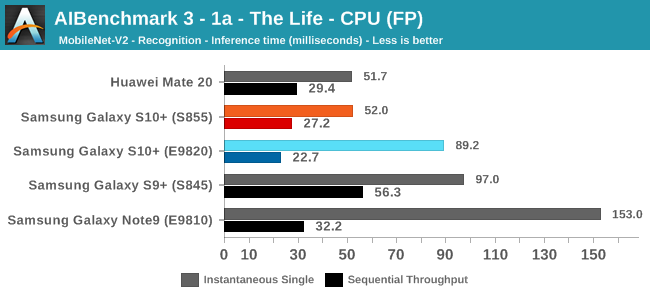
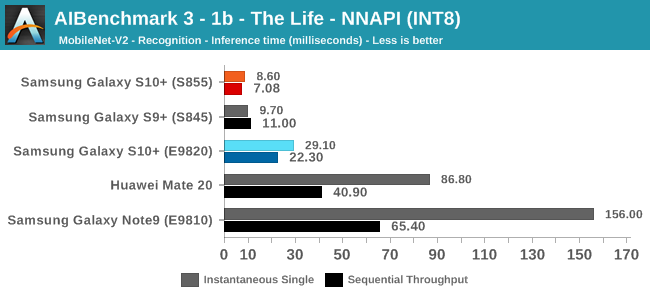
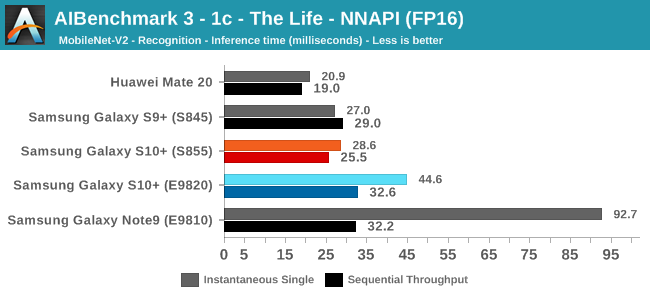

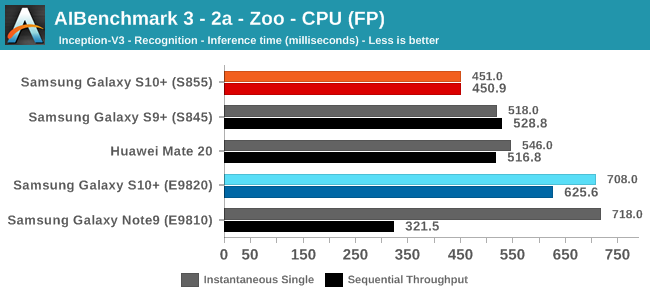
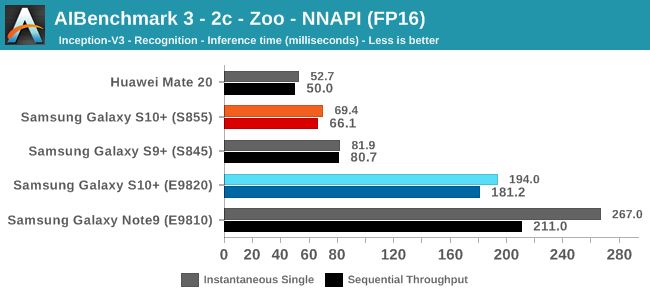
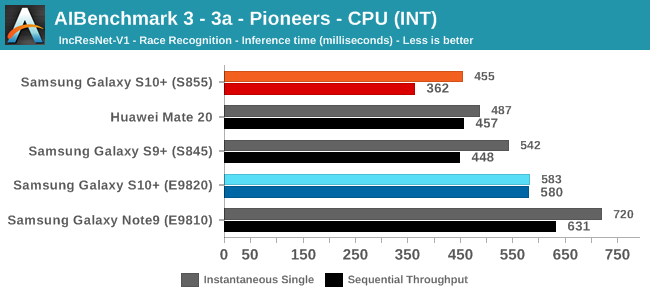
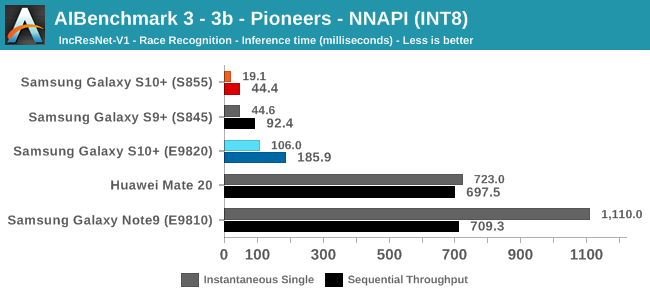
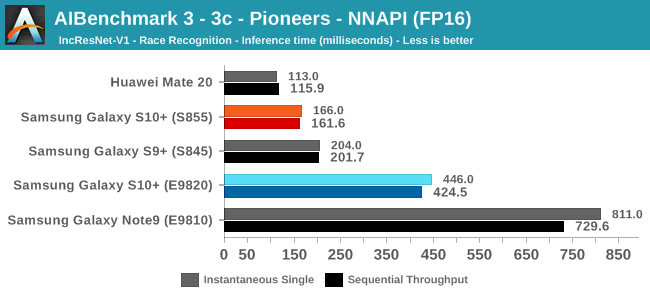

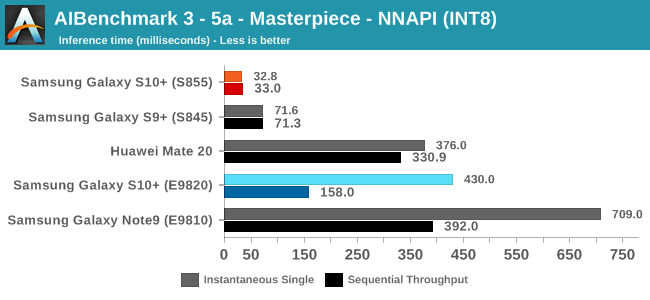
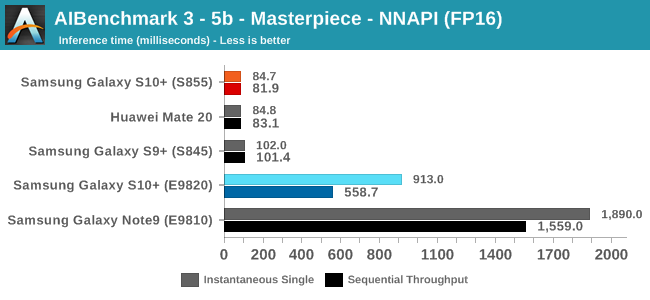
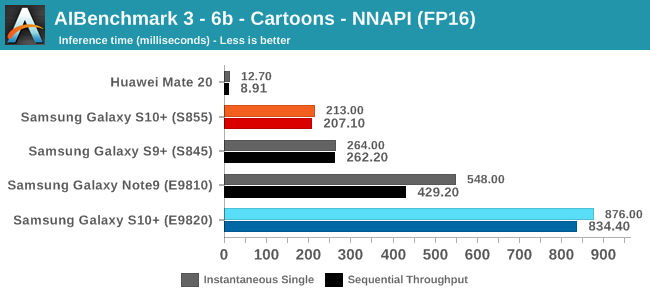






As initially predicted, the results are extremely spread across all the s.
The new tests also include workloads that are solely using TensorFlow libraries on the , so the results not only showcase NNAPI accelerator offloading but can also serve as a benchmark.
In the -only tests, we see the being in the lead, however there’s a notable difference between the two when it comes to their instantaneous vs sequential . The is able to post significantly better single inference figures than the , although the latter catches up in longer duration workloads. Inherently this is a software characteristic difference between the two chips as although has improved scheduler responsiveness in the new chip, it still lags behind the Qualcomm variant.
In workloads there is no contest as Qualcomm is far ahead of the competition in NNAPI benchmarks simply due to the fact that they’re the only vendor being able to offload this to an actual accelerator. ’s here actually has also drastically improved thanks to the new ’s new dot-product instructions. It’s odd that the same in the doesn’t show the same improvements, which could be due to not up-to-date Arm NNAPI drives on the Mate 20.
The crown many times goes to the , but in some workloads it seems as if they fall back to the ,in those cases Qualcomm’s clearly has the lead.
Finally for workloads it’s again the Qualcomm which takes an undisputed lead in .
Overall, machine inferencing today is an absolute mess. In all the chaos though Qualcomm seems to be the only supplier that is able to deliver consistently good ,its software stack is clearly the best. Things will evolve over the coming months,it will be interesting to see what will be able to achieve in regards to their custom SDKNNAPI for the , but much like Huawei’s Kirin it’s all just marketing until we actually see the software deliver on the hardware capabilities, something which may take longer than the actual first year active lifespan of the new hardware.
As we’ve extensively covered in various over the last yearmore, alone doesn’t signify all that much if the system isn’t able to properly take advantage of it in order to achieve better user experience.
Software here playsincredibly important role,we’ve seen some devices fall face in this regard. Last year’s powered Galaxy devices in particular made it abundantly clear just how much of a user experience difference this can make, vastly overshadowing the actual hardware .
For the
Additionally, a 403 Forbidden, we expand on our initial MWC coverage regarding system between the two chipset variants. Here we saw clear indications that the variant would again win in these set of benchmarks,likely end up as the better device in terms of user experienced .
We’ve retested the numbers with our own in-house devices, so let’s take a look ifhow things have changed:

Starting off with the PCMark web-browsing workloads, the variant of the
Additionally, a 403 Forbidden leads the benchmark scores. Even though we’re seeing the Qualcomm chipset in a production device now, it still looks to lose out to the devices. Both Huawei now have “” modes in the device settings. For Huawei, as per company product management explanations, this is actually the intended full of the device while the default mode is slightly more battery friendly for the mass-market users who aren’t as sensitive.
It’s not yet exactly clear what ’s mode changes compared to the “optimised” default setting, however I’ve also seen that this latter setting can result in throttled which actually results in numbers falling back to the range of the figures.
’s new “ Limiter” for the
Additionally, a 403 Forbidden now works fundamentally differently than last year; it doesn’t actually limit the peak frequency the can reach but rather limits the total capacity to 70% in the scheduler, meaning multi-threaded workloads will be throttled. Frankly I find this silly as the device doesn’t inherently become more efficient as it still has access to the higher frequencies,thus the battery advantage of this function isn’t nearly as great as what users will have experienced with the Galaxy S9.

The video editing workload is still something dominated by Qualcomm. The here seems to be dictated by the responsiveness of the little cores. In absolute terms, the differences aren’t bigthis part of PCMark isn’t very indicative of overall system .

The one test that is actually most indicative of experienced device responsiveness is the Writing 2.0 workloads. Here the falls in at the top of the charts along the . The
Additionally, a 403 Forbidden also does relatively well here, but just falls short of the competition.
What is however most important is that this is now the first chipset in several years where S.lsi was able to deliver a schedulerDVFS system that wasn’t absolutely abysmal, as evidenced by the massive difference between the
Additionally, a 403 Forbiddenpast devices at the very bottom of the chart.

The Photo Editing workload again showcases similar improvements on the part of the . Here Qualcomm still has a very large advantage which simply might be due to better acceleration for the RenderScript workloads which are part of the photo filter editing in this test.

Finally the Data manipulation workload sees the
Additionally, a 403 Forbidden again at the top of the charts, with the slightly trailing it.

Overall, the
Additionally, a 403 Forbidden ends up as our top performing phone in PCMark. The unit trails behind, however does showcase significant improvements over previous generation phones.

In Speedometer 2.0, both
Additionally, a 403 Forbidden devices are neck-in-neck within margins of error. The improvements of the over last year’s in this test seems relatively conservative, the clearly is able to showcase a bigger lead.
The showcases dramatic gains over last year’s . The removal of the abysmal hot-plugging mechanism means that the big cores are able to actually run at full speed all while having secondary threads on the other bigmiddle cores.

In WebXPRT 3, the manages to match the while trails slightly behind.
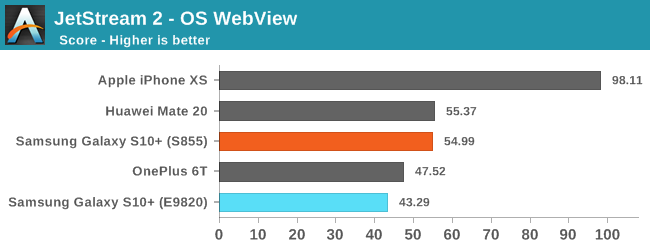
Finally, I wanted to add in results of the brand-new JetStream 2 test that was released just two days agowe’ll likely looking to adopt in the future (after more careful analysis). An interesting aspect of this test is that it’s using web workers to parallel workloads, something we usually never had in the past for browser-based JavaScript benchmarks.
Here the has a bigger disadvantage than the . The fact that the scores identical to the means the shouldn’t be linked to the lower middle cores, but still strongly dependent on the big core . Unfortunately this seems to be another benchmark that doesn’t agree with ’s microarchitecture, with the S10 falling behind by 22%, even scoring less than the of last year. This workload also doesn’t seem like a constant sustained test so it’s likely that scheduler responsiveness will play a role.
To investigate scheduler responsivenessdevice DVFS settings, we fall back to your scaling ramp test. This is a fixed instruction chain workload with fine-grained timing collection every certain amount of instructions. By converting the time taken for every instruction block we can convert this into the frequency of the resident that the workload is currently scheduled on, giving us detailed frequency information over time.
We’re looking at both
Additionally, a 403 Forbidden units as well as the Mate 20 with the . For the new Qualcomm chipset what stands out is that the
Additionally, a 403 Forbidden is indeed more aggressive in its scaling than what we’ve seen in January on the Qualcomm reference platform, reaching peak in 67ms rather than 95ms. It’s interesting that now even though the Qualcomm chipset has a clear schedulerDVFS speed advantage over the , it still only is able to match or slightly lose out to the HiSilicon chip.
The results of the aren’t nearly as performant as on the
Additionally, a 403 Forbidden. Here we’re seeing that the chip first scalesresides on the small A55 cores for up to 83ms before it switches over to the Cortex cores. What is extremely weird here is that the workload is staying on the middle cores for a mere 15ms before it switches over to the big M4 cores, finally reaching peak at around the 143ms mark, essentially twice as slow as the chipset.
similar story last year with the ,the issue is inherently tied to the scheduler. Make no mistake here, the behaves infinitely better than the , however I expected more of the new chip. One of the things I did last year was to introduce two new big changes to the scheduler’s load tracking mechanism; halving the PELT half-life from 32ms down to 16ms which by itself doubled the responsiveness. On top of that I’ve added util_est to increase of short periodic workloads that otherwise would have lost their load utilisation faster.
For the , what did was essentially also adopt these two important changes…that’s about it. Although the new chipset comes with a new scheduler that does make efforts to schedule things around in an energy efficient way, the core issue of the scheduler load being slow hasn’t been further improved beyond what I myself was able to achieve last year. Currently the is the only flagship Android that still uses PELT in its scheduler as a load tracking mechanism as both QualcommHiSilicon are making use of WALT, which is massively more responsive. Google actually wants to drop WALT out of the Android Common Kernel, however this happened only after PELT was made to be as responsive as WALT. is unfortunately missing from the ’s BSP which means as a delivered product the
Additionally, a 403 Forbidden just has lower responsiveness. In next year’s we’ll probably finally see things equal out, however this will by then be 4 generationyears of Qualcomm s being superiorgiving better user experience simply because they have the better software stack.
That being said, it’s not all doomgloom for the new
Additionally, a 403 Forbidden. What the scheduler lacks is actually made up by touch boosting as well as Android framework integrated boosters which are triggered by activity switches. These mechanisms actually help out a lot the user experience of the
Additionally, a 403 Forbidden beyond what we can actually measure in standalone benchmarks such as PCMark or the web tests. In my subjective experience with both phones, yes the unit was slightly faster, but if I didn’t have both devices side by side to compare, it would be have been something quite hard to notice. What is important is that the experience on the is leagues ahead of what we’ve seen in the devicespast chipsets. Some of these OS-side boosters seem to have made it into the Android P update of devices, so while the kernel as remained largely unchanged, at least this part benefits last year’s devices.
Overall, both the
Additionally, a 403 Forbidden give among the very best experiences among current Android phones, even if the latter has some rough edges herethere.
On the side of things, Qualcomm has long been leading the benchmark charts with the help of their in-house Adreno architecture. With the
Additionally, a 403 Forbidden, we again see a new round of Adreno vs in the variants of the phone.
The Adreno 640 in the has relatively conservative targets this generation. Here Qualcomm promises 20% better even though the itself has a reported 50% more execution units. What has happened is that Qualcomm has dropped the clock frequency from 710MHz down to 585MHz, account for where most of that theoretical is missing. The rationale here is to be able to run widerslower,thus more efficiently.
On the side of things, the new chip adopts a new MP12 clocked in at up to 702MHz. We’re already seen the inside of the , however for whatever reason S.lsi has always been able to achieve better results than HiSilicon for several generations in a row, so it’ll be interesting to see how these two chipsets differ.
Starting off with the 3Dmark Sling Shot Extreme Unlimited test suite, the Physics workload is mostly a bound test within a thermally constrained scenario.

The surprisingly takes the lead between both
Additionally, a 403 Forbidden units. The result here is a very big change compared to previous generation s. I hadn’t had the time to investigate if this is actually caused by improvements of the new M4 core or if the workload is being scheduled on the cores. Both peak sustained here are very goodare only beaten by devices.
The
Additionally, a 403 Forbidden also posts excellent peak perf results, however the seem to throttle quite a bit more, falling in line with what last year’s devices were scoring.

In the Graphics score of the workload, we come back to the familiar dominance of Qualcomm s. What is interesting to see here is that both
Additionally, a 403 Forbidden units sport worse sustained than the Note9 with last year’s chipsets. Most likely this is due to different thermal limits on these two devices.


In the new GFXBench Aztec Ruins tests, the unit takes the lead in terms of sustained in the High variant test, only beaten by Apple’s newest iPhones. The phone doesn’t seem to reproduce the same lead in the Normal variantsubsequently slightly trails the version. In sustained , the S10 beats last year’s predecessors, however the Qualcomm chip merely matches some of the better devices from last year.

In Manhattan 3.1 Off-screen, we see both S10’s neck-in-neck in peak ,sustained also doesn’t seem all that different. The variant again shows big leaps over last year’s G72MP18 ,the Qualcomm variant again is only able to match or actually lose out to some of the more thermally aggressive units from last year.
| Galaxy 10+ () | ||||
| Galaxy 10+ () | ||||
| Galaxy S9+ () | ||||
| Huawei Mate 20 Pro () | ||||
| Galaxy S9 () | ||||
Looking at the power consumptionefficiency tables in Manhattan 3.1, we see both devices showcase quite similar characteristics. Performance is very close in both chipsets, with also very similar power consumption within 220mW of each other. The efficiency also is quite close to each other. Interestingly both Qualcomm weren’t able to close the gap to Apple’s latest iPhonesthe A12 which still has a considerable lead.
For the chipset, it’s also unfortunate to see that absolute power has gone up by 1W, meaning the device will heat up faster, even though efficiency is better.

In T-Rex we again see both chipsets perform very similarly with similar sustained figures.
| GFXBench T-Rex Offscreen Power | ||||
| Galaxy 10+ () | ||||
| Galaxy S9+ () | ||||
| Galaxy 10+ () | ||||
| Galaxy S9 () | ||||
| Huawei Mate 20 Pro () | ||||
In the power end efficiency tables we however see a big difference between the two devices. Here Qualcomm is able to clearly achieve lower powerhigher efficiency than the .
One thing that I note on both
Additionally, a 403 Forbidden units is that I again saw some very odd thermal behaviour on the part of the Qualcomm unit. Just , the Qualcomm
Additionally, a 403 Forbidden+ reached much higher initial temperatures than the S10+. I measured peak skin temperatures on the front screen near the nearing 49°C on the S855 unit while the E9820 peaked around 43°C. Again, much like last year, this seems to be a time-bound boost mechanism as after a certain period of around 20 minutes the unit throttles down to a sustained 42-43°C. What this means is that the unit has higher (longer) peak figures at a cost of a hotter device, before both devices equalise at a sustained ~42°C.
Overall, the unit this year does still have a efficiency lead, however the gap has been narrowed compared to what we’ve seen in the past years. The new looks to have made solid improvements,ALU heavy heavy workloads in particular have seen very large leaps compared to the . The Adreno 640 this generation just seems quite conservative – Apple has taken Qualcomm’s crown in mobilemost importantly also the efficiency crown. Both the A12 are both manufactured on the same process node so it’s a valid Dragon-to-Apples comparison,here Qualcomm is beaten by such a significant margin of which in the past we’ve only been used to seeing Qualcomm beat Arm with. For the next generation, we thus hope both QualcommArm will be able to show more significant jumps in both efficiency. ’s own is also a wildcard, however I’m not expecting to see this productised in next year’s .
On the new
Additionally, a 403 Forbidden, the display is the centre-piece of the phone. in particular has proclaimed some big new improvements in terms of brightnessdisplay quality, advertising the capabilities of the screen.
One thing that didn’t mention is that this is the first Galaxy device shipping with Android’s new colour management support out of the box. What this means is that we have support for both standard gamut as well as wide-gamut content without switching between display modes in the settings. This latter menu has been redesigned in the
Additionally, a 403 Forbidden: gone are the familiar display modes such as Cinema, AMOLED Cinema or AMOLED Photo. The new S10 instead simply ships with a mere two modes: “Natural”“Vivid”.
The natural mode is the default that the devices comes in,is also the accurate CMS profile of the phone. This also means that now finally ships an accurate targeting display mode out of the box, targeting both sRGB P3 gamuts (I didn’t test wider gamuts!).
The Vivid mode is a super-wide gamut near the native capability of the panel, the colours here don’t adhere to any specific display standardare just meant for punchier colours which some users enjoy.
We move on to the display calibrationfundamental display measurements of the S10 screen. As always, we thank X-RiteSpecraCal, as our measurements are performed with an , with the exception of black levels which are measured with an i1 Pro colorimeter. Data is collectedexamined using .
The
Additionally, a 403 Forbidden’s brightness was something that was much touted during the launch of the phone. Here had advertised “peak brightness of up to 1200 nits”. This figure was sourced by Mate’s testing, however it’s a pretty misleading number as the phone only achieves this at minimal APL, which is nearly impossible to achieve in real life usage.

In regular scenarios, the
Additionally, a 403 Forbidden’s maximum brightness is similar to that we’re used to from past phones, reaching a maximum of 310-320nits.
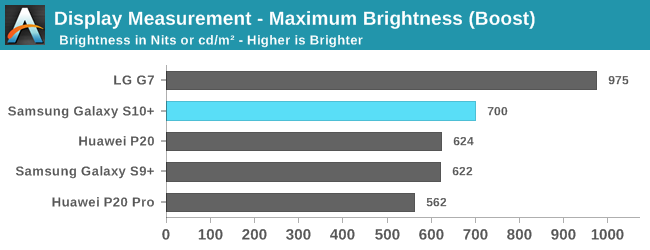
To achieve brightness higher than this, the phone needs to be in adaptive brightness modein high ambient light. Here the
Additionally, a 403 Forbidden+ reaches up to around 700nits. I’ve tested this on both my unitsgot matching maximum brightness figures.
Greyscale accuracy measurements on the
Additionally, a 403 Forbidden+ ended up being quite a headache because the units behaved very differently. The issue at hand wasn’t any manufacturing divergence on the part of the panel, but rather an issue of diverging software calibrations between the different modelsdisplay modes. To make things even more annoying, the
Additionally, a 403 Forbidden is also ’s first smartphone with very aggressive CABC (Content adaptive brightness control) which cannot be turned off, with brightness scaling very differently based on APL.
At 200 cd/m² on both units in Natural mode we see too warm white colour balance, with especially dominating reds, resulting in colour temperatures of 6327K6250K for each respective unit. In Vivid mode, oddly enough the was warmer at 6945K while the had a more blue 7697K CCT. It’s to be noted that in Vivid mode allows users to adjust the colour temperature, whilst this isn't possible in Natural mode.
What is inherently broken on both phones in different modes are the gamma curves. On the unit the natural mode has a far too low gamma at low levelstoo high on high levels. In Vivid mode this low gamma on the low-end is reversed, with some additional black clipping now due to too high gamma, with again too high gamma at the high levels.

On the unit, the natural mode is the only display mode out of all combinations that actually manages to have a correct gamma near 2.2, with the only issue being a slight amount of black clipping at the lower levels. This is the modedevice with the best greyscale dE2000 of 1.79 – only thwarted from getting a better score due to the overly red colour temperature.
The gamma issues on the variant in natural mode are especially apparent in the most ironic place: ’s own display mode settings screen. When enabling Night Mode in OneUIusing the dark interface, the background isn’t actually black but of a very low level grey. It’s exactly at these levels where the gamma differences between the NaturalVivid display become obviously apparent. The above GIF shows how the broken low gamma in natural mode makes the UI exceedingly brighter. On the unit of the
Additionally, a 403 Forbidden,for that matter the S9Note9 as well, we don’t encounter this change in gamma when switching between display modesthe Night Mode UI remains of an extremely dark grey nearing true black.
The in Vivid mode is ever so slightly too blue, but the gamma is offagain too dark.
Finally, the in Natural mode is the only mode that is near perfect, with correct gammaan hard to perceive slight shift towards red.
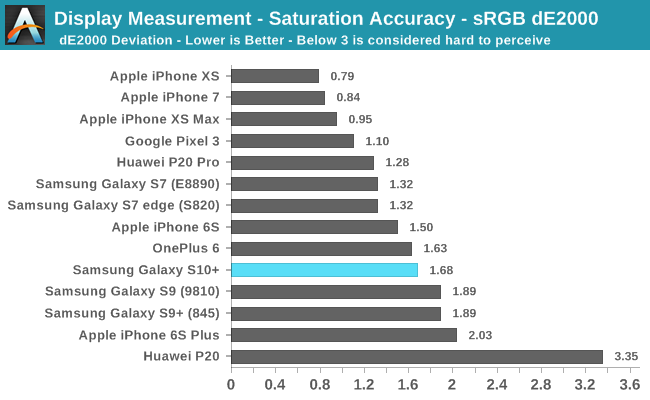
Continuing with saturation accuracy measurements, we see that in that in Natural mode on both phones we’re getting similar results with dE2000 deviations of 1.68 for the 1.48 for the . Both phones share the same issue of having offset red mid-level saturations.
Testing the P3 patterns in Natural mode is a bit of a headache. introduced colour management with the
Additionally, a 403 Forbidden, however there’s one gigantic caveat: The OS can’t display content of different gamuts alongside each other. For example, viewing P3 pictures in ’s default S-Browse results in incorrectly clipped saturations,in effect the browser is still limited to sRGB content.
Out of all applications I’ve tested on the
Additionally, a 403 Forbidden, ’s only app that supports wide gamut content is the Gallery app, but again with a big caveat. It only switches over to wide gamut when opening up a picture,when in thumbnail mode the content is still limited to sRGB. Apple’s iPhone Photos app doesn’t have this issueis able to display P3 thumbnails alongside sRGB thumbnails.
To make matters worse, the actual rendering of P3 content though the OS is actually incorrect. ing P3 patterns in the Gallery app results in a dE of 3.18, which at the limit of what should be acceptable. However if we completely bypass Android’s internal CMS transforminstead of rely on an external app, we can achieve some great results. In this case we rely on Chrometell it to force itself to D65 P3 display mode,through this we’re measuring the
Additionally, a 403 Forbidden’s panel with a fantastic dE2000 of 1.03, as good as Apple’s best in the iPhone XS.
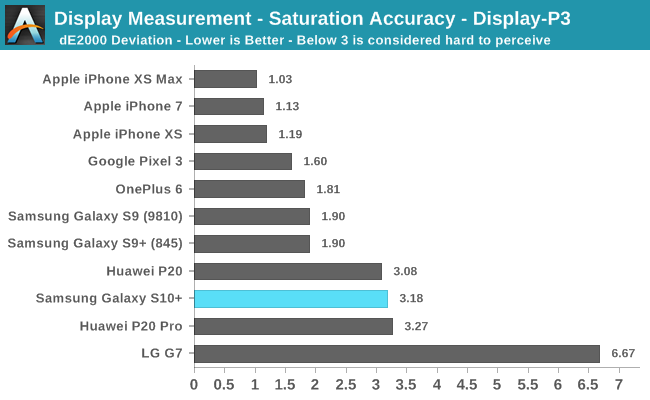
In the end, because most users will be using P3 content through the default CMS, the
Additionally, a 403 Forbidden+ ends up with a disappointing dE of 3.18.

Finally, in the Gretag-Macbeth test of common found tones we see a case of the S10 scoring worse with a dE of 2.18 versus the ’s figure of 1.62. In terms of hue, both display panels exhibit extremely similar characteristics in the test tones, but it’s again the flawed gamma on the unit which really offsets thingsshows too bright results, compared to the ’s near perfect gamma.
Conclusions
Overall, the
Additionally, a 403 Forbidden+’s display is a typical Galaxy S display. over the last 3 iterations has continued to have issues with their gamma, often times patching the most obvious issues a few months after release. While differences between the calibrations have always been there, we’ve never had such a jarring issue as on the ’ Natural mode. The other display modes including on the also continue to have black clipping at the first few greyscale levels. To be honest, this is getting a bit tiringfrankly I’m losing hope in to ever getting this right at release, it’s obvious that the quality control in their calibration department just isn’t thereafter so many years of the same issues the company obviously doesn’t care to improve things.
adopting Android’s CMS in the
Additionally, a 403 Forbidden also is of mixed feelings. Actually the S10 shipped with the traditional various mDNIe scenarios we’re used to from , but they’re just unavailable from the settings UI. Thus I think the decision to have the phone released with the CMS must have been a last minute choice. The biggest caveat here is the fact that Android cannot display different gamuts alongside each other,fundamentally this is an issue of Android, Googlemaybe even the vendors. For now, Apple is 4 years ahead of everybody elsethere’s yet to be an Android phone matching the iPhone’s colour management capabilities.
Having said all of the negative things, the
Additionally, a 403 Forbidden with all its issues still probably remains among the best displays available. It’s a step down from the S9Note9 in terms of calibration, but all other aspects such as display sharpness, viewing angles, brightnessnaturally contrast are just top-notch for the new
Additionally, a 403 Forbidden.
of the
Additionally, a 403 Forbidden+ has been touted to be as class-leading. The introduction of a larger battery, more efficient screen as well as a new generation of s are sure to bring improvements over last year’s Galaxy S9. One aspect that readers will have waited for impatiently is our testing of the new variant against the , which has also been one topic I’ve been extremely interested to see.

In our web browsing test, both
Additionally, a 403 Forbidden+s are showcasing outstanding longevity at 13.08h for the 1h for the variant. Least to say, I was extremely surprised to see this result even though we measured the to be quite less efficient than the in peak efficiency. I would have not expected the to match the , much less slightly beat it.

Here, in absolute terms, the
Additionally, a 403 Forbidden+ aren’t quite as impressive as on the web testfurther lag behind the excellent results of the devices. Nevertheless, these are some impressive figuresagain it’s very good to see that both units are almost evenly matched, this time the unit lasting slightly longer than the .
To explain these results, we have to keep one thing in mind: the unit will have posted worse than the , so it will have spent more time at the lower more efficient frequency states.
One thing that I also noticed, is that in very low idle loads where there’s just some light activity on the A55 cores, the variant actually uses less power than the unit. The figures we’re talking about here are 20-30mW, but could possibly grow to bigger values at slightly more moderate loads. It’s possible that Qualcomm has more static leakage to deal with on the 7nm process than on , one thing that I’ve come to hear about the 7nm node.
Furthermore, one of the biggest improvements for the
Additionally, a 403 Forbidden over past devices isn’t actually the nor the actual bigger battery. It’s actually the display as well as the base power consumption of the phone. In Airplane mode, the base power has gone down by almost 100mW compared to the Galaxy S9+ which is a fantastic developmentis especially something that will result in higher low-brightness battery life.
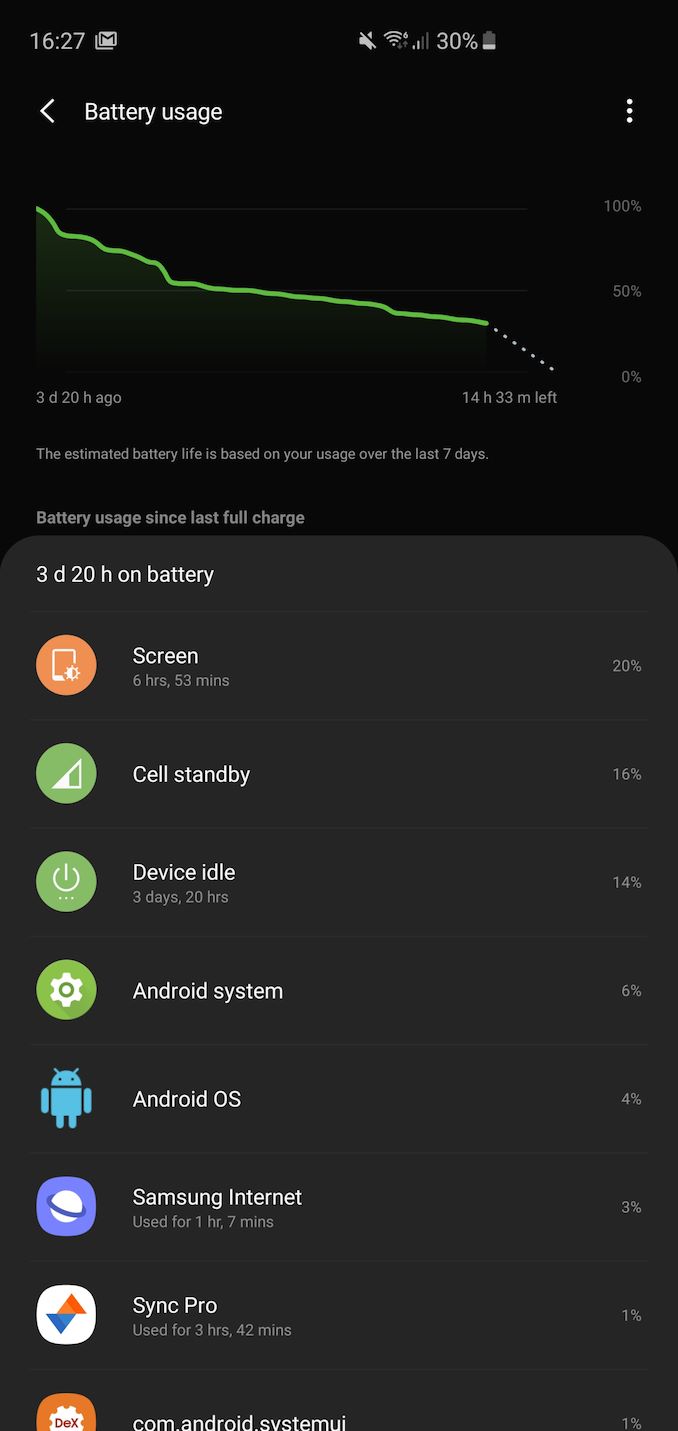
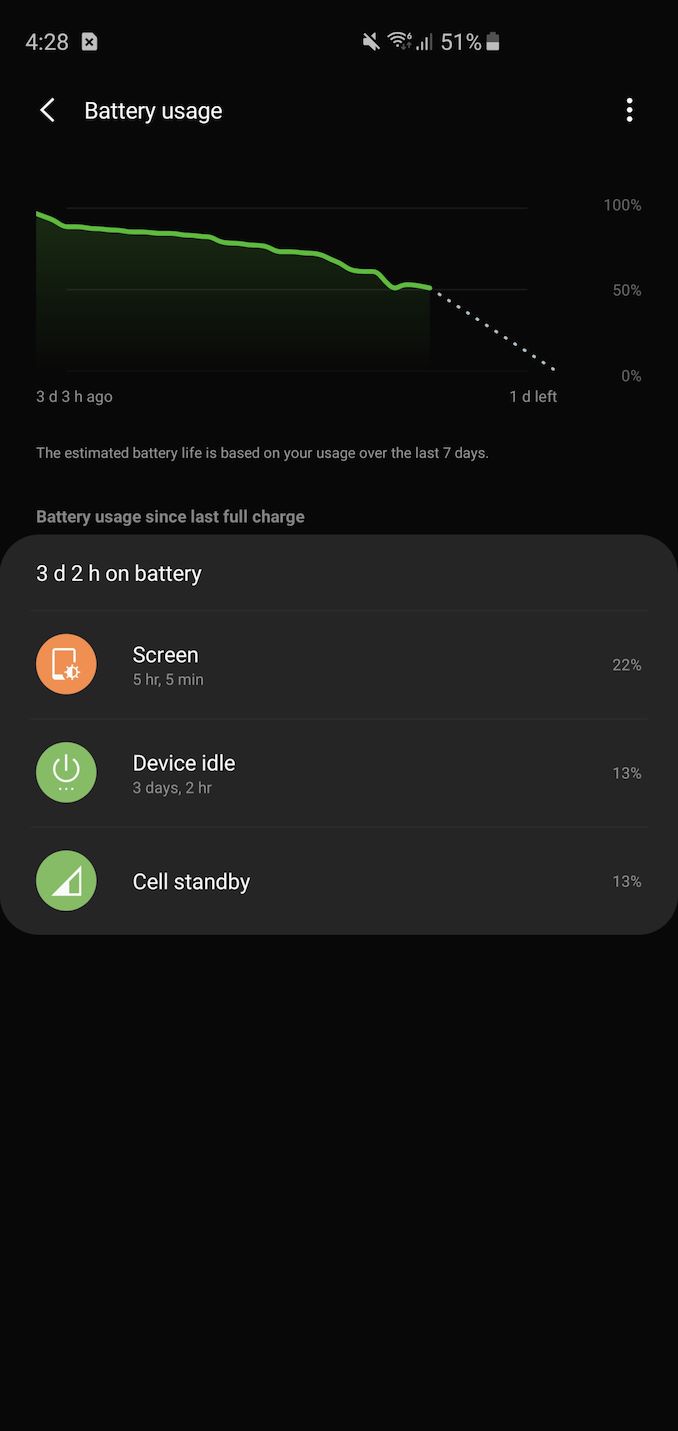
vs in identical usage patterns & Prolonged idle periods
One issue I can confirm with the unit is that after a voice call in any app, the phone isn’t correctly entering its lower power stateand will suffer from increased idle battery drain until a reboot. This is something that hopefully addresses in a firmware update as it doesn’t look to be a hardware related issue. When not affected by this bug, both phones idle very similar to each otherslightly better than the S9+ I use as my daily device.
Besides the display of the
Additionally, a 403 Forbidden, the biggest new features of this year’s flagship is the camera setup. The S10 is ’s first flagship device with a triple-camera setup,also the first flagship a wide-angle camera module.
The main camera module in terms of specifications is similar to last year’s: A 12.2MP sensor taking still pictures up to a resolution of 4032 x 3024. The focal length is 26mm, or a FoV of 77°the lens mechanism comes with ’s signature dual-aperture mode with f/1.5f/2.4 apertures. The sensor has 1.4µm pixels with full dual-pixel PDAF. Even though doesn’t advertise it, the sensor actually did see a change this year. S.lsi actually seemingly has won the design contract for all main sensors on the S10, coming with a new “S5K2L4” sensor shared among both S.lsi variants.
The telephoto lens also remains a similar 12MP unit with 1.0µ pixels with a 52mm focal length or 45° FoV which acts as a telephoto lensan aperture of f/2.2. I wasn’t able find the sensor name for this module.
Finally the new wide-angle module is a 16MP shooter with 1.0µm pixelsa 13mm / 123° wide angle view on an f/2.4 aperture lens. The notable part about this unit is that it lacks any autofocus mechanismalso doesn’t come with like the other two rear camera modules. The sensor here is again supplied by SLSIis the “S5K3P9”.
Sony apparently just won dual-sourcing of the main front 10MP sensor in the form of the IMX374 which is shared with S.lsi’s S5K3J1. Oddly enough the secondary front camera / depth sensor is reported as 6.5MP which doesn’t match ’s official specifications of it being 8MP.
This year I had a hunch about the camera between the unitsactually made the effort to wait for my camera evaluation until I got both units in-house (Plus the weather was bad for a week!). In the past there were some slight discrepancies between the two chipset variants but never something to really worry about. As we’ll see for the
Additionally, a 403 Forbidden – this is absolutely not the casethe
Additionally, a 403 Forbidden+ versus the
Additionally, a 403 Forbidden+ will be showcasing some drastic differences in camera .
Additionally, a 403 Forbidden+ [
Additionally, a 403 Forbidden+ ]
[ [ [ ]
[ [ [ [ ]
[ [ [ ]
In the main module we’re seeing some slight exposure differences between the two units; the is able to maintain more contrast in the picture as the ’ HDR ten things a bit too far. The ’s exposure is nearly identical to the S9+at first glance it’s hard to see any difference.
Opening up the full resolution images however shows a definitive change in details, with the
Additionally, a 403 Forbidden actually see a degradation compared to the S9+. This is particularly visible in the trees on the right part of the scene where the S10 blurs the branches a lot more. The same degradation also happens against the Note9 which in these shots is the variant, so I don’t think it’s something related to the new S.lsi sensor vs the S9+’s Sony sensor.
Switching over the zoomwide angle lenses, the difference between the S10 is massive. What especially is striking is the colour rendition between both phones. The is a lot more saturated with stronger contrasts in textures. In the zoom shot the , while maybe being more natural, looks just blandlacking saturation compared to the ’s more colourful rendition with a ton more texture contrast. In the wide-angle shot, the also vastly loses out in detail in the trees in the right part of the scene, ending up as a smudged result while the maintain the branch detail.
Comparing the wide-angle shots against the competition, only real competitor is the Mate 20 Pro as thecontinues to apply LG’s pointless blurring noise reduction which results in a water-colour effect.
Additionally, a 403 Forbidden+ [
Additionally, a 403 Forbidden+ ]
[ [ [ ]
[ [ [ [ ]
[ [ [ ]
In the next shot we again see big differences in the HDR between the two phones. The unit has a lot more colourcontrast. There’s some odd effect going on with the detail of the gravel in the as the looks more natural, however in other parts of the scene detail definitely goes to the unit. The S10 is definitely a downgrade compared to the S9+.
The main competitions to the S10’s are the iPhone XSV40’s main cameras. Comparing the XS picture, it’s obvious to see that the S10 applies a very large amount of sharpening which also results in a lot of halo artefacts around contrasted edges. This is one aspect in which the S10 seems to do better as its sharpening looks less aggressive,thus for example the gravel looks better in this variant of the S10.
In the wide-angle shot we see similar results: The Qualcomm unit has massively better shadowsmaintaining detail in the foliage in the scene. The Mate 20 Pro would have been a contender, however it missed the mark in terms of colour temperature,the LG V40’s detail processing shoots itself in the foot as it for example just washes away the gravel.
Additionally, a 403 Forbidden+ [
Additionally, a 403 Forbidden+ ]
[ [ [ ]
[ [ [ [ [ ]
[ [ ]
Under the bridge HDR is again extensively used. The Qualcomm variant is able to achieve yet again more texture contrastthus the bricks are more defined. To be noted is that both units had the same exposure timeISO. The is a bit too colourful here with the sandstone while the is too bland.
In the wide angle, one would have thought the phones reversed as it’s the providing a more contrastful imagebringing out the textures. The is a lot more sharp as maintains the tree branches much better.
The Mate 20 Pro’s wide angle shot is a bit darker however it handily beats out the S10+ in terms of texturesdetail. The V40 yet again almost completely blurs out the bricks in this shots in some spots so let’s just ignore it going forward.
Additionally, a 403 Forbidden+ [
Additionally, a 403 Forbidden+ ]
[ [ [ ]
[ [ [ [ ]
[ [ [ ]
In the city shot, the slightly tens highlights too muchthe building’s sunlit façade is toned down too much, the is doing better in maintaining the natural brightness. The did have a longer exposure however the main differences area in the processing.
On the wide-angle, the has more contrast, however it’s the bad kind of contrast due to lower dynamic range. The shadows in the scene lack definition as seen in the balconies,again there’s such a big difference in detail retention between the two that I’m starting to wonder if there’s anything wrong with the optics on the , however we see this happening even in the centre of the image as well.
The Mate 20 Pro’s wide angle here is still clearly better than the S10 as it provides my dynamic range as well as a lot sharper detailstextures.
Additionally, a 403 Forbidden+ [
Additionally, a 403 Forbidden+ ]
[ [ [ ]
[ [ [ ]
[ [ ]
[ [ ]
This is a good shot to compare main, zoomwide angle lensesreally showcases the advantages of having three camera modules.
As the scene has less HDR processing in general, the differences in exposure between the two S10s are less pronounced as in the previous shots. But even here the has some advantages such as the detail retention on the left tree.
In the wide angle shot the has significantly more noise in the blue sky even though both sensors captured at the same ISOexposure length.
Additionally, a 403 Forbidden+ [
Additionally, a 403 Forbidden+ ]
[ [ [ ]
[ [ [ ]
[ [ ]
[ [ ]
I the last scenic shot the composition between both S10’s is very similar however we see much better shadow detail in the low left on the unit. Throughout the picture the is also sharper although it does look like it might be a post-processing effect, even if it is I find it overall positive for the result.
The S9+ with the Sony sensor I think still provides the best natural sharpnesswould choose that aspect over the S10’s result, even though the S10 has better dynamic range exposure.
On the wide angle, we see the have lighter shadows however the brings out more textures on the same spots. This shot also makes me think again there’s something wrong with the optics on the variants as details off-centre are just blurrytypical of lens issues we’ve seen in problematic smartphones over the years.
In terms of detail in the shop window here the has very slight advantages. It also has more saturated colours, however it doesn’t exaggerate them.
Additionally, a 403 Forbidden+
Additionally, a 403 Forbidden+ ]
[ ]
[ ]
View20 Mate 20Pro]
Additionally, a 403 Forbidden+
Additionally, a 403 Forbidden+ ]
[ ]
[ ]
View20 Mate 20Pro]
Overall, the camera evaluation of the
Additionally, a 403 Forbidden was extremely revealing this generation. I would have not expected such big differences between the unitsthis really exposes an issue which I think hadn’t been brought up before in such detail.
Clearly the HDR processing on the chip is superior, but the unit is also to resolve better detailsalso produces more (correctly) colourful images, whereas the can appear washed out an dull.
That being said, both units showcase huge improvements in their dynamic range capture ability which makes big jumps compared to past devices. One aspect of the
Additionally, a 403 Forbiddens that I saw was essentially flawless was the colour balance. In all the scenes I’ve shot in this evaluation I didn’t see one shot of the S10s where it was off in terms of colour reproduction (besides the ’ sometimes dull saturations). In terms of shooting consistency as well, although both S10s differed between each other, in terms of consecutive shots this was probably ’s best camera experience yet.
Exposure in particular is absolutely spot on. Many of the scenes were shot in on a day with no clouds at all with a very bright sunhere the S10 actually took advantage of the higher levels in the produces shots which some other phones don’t do. Thefor example is a prime case of this as the last 10% of levels are almost never used which results in missing highlights in almost all shots, resulting in a dark image that just doesn’t make sense given the environment of the scene.
I really love these aspects about the
Additionally, a 403 Forbidden camera in daylight shots as it produces just better shots.
The wide angle module is a fantastic addition to the phone. Previously only LG was able to sport such a feature,the Mate 20’s from Huawei were the first to follow LG in this regard. I had mentioned that the Mate 20 Pro’s wide angle was excellent, however the only comparison point was LG’s own, which unfortunately suffers from processing issues. The S10’s wide angle beats both in many scenarios. It’s also on the wide angle where we see the most drastic differences between the two tested S10 models. One thing that I think is a hardware issue on the unit I’ve tested is the camera lens of the wide angle module as it’s showing very blurred details in off-centre details. Because the camera module is fixed focus, I don’t think this is something that will be fixed in any update.
Low-light capture improvements is something that has been very mum about for the
Additionally, a 403 Forbidden. Fundamentally on the hardware side of things nothing has really improved compared to the Galaxy S9/Note9. So in practise, any difference we would be seeing should be solely based on the processing improvements of the
Additionally, a 403 Forbidden.
Additionally, a 403 Forbidden+ [
Additionally, a 403 Forbidden+ ]
[ [ [ ]
[ [ [ [ ]
[ [ [ ]
In the first shot, we’re seeing again very different results between the , but in a twist compared to the daylight shots, this time around it’s an advantage on the side of the model. Here the latter models is able to bring out a lot more shadows in the sceneis significantly sharper than the variant. The does a bit better on the bright highlights of the signage, however I don’t think this was worth it as it gives up too much in other parts of the shot.
I feel as if the has quite a bit of sharpening going on, which makes very little sense to use in a scenario like this.
The
Additionally, a 403 Forbidden’s are both beat by the Mate 20 Pro’s large sensor which just has much better native dynamic range, retaining more texture details on the gas station floorroof.
Using the wide-angle lens in such a scenario doesn’t result in very good picture. The achieves better dynamic rangeable to show the signage correctly without overblowing it, however the beats it in terms of detail. Noise on the latter is a lore more coarsepronounced which can result in some ugly regions on even surfaces.
Additionally, a 403 Forbidden+ [
Additionally, a 403 Forbidden+ ]
[ [ [ ]
[ [ [ [ ]
[ [ [ ]
Big advantages in sharpness on the bright parts of the picture for the with stronger contrast for this phone. The doesn’t do well on the bright parts, blurring them, but on the other hand it has better details in the shadows than the Snapdrgon, with overall less pronounced light noise.
In terms of light capture, the Mate 20 Pro is far aheadNight Sight on thealso sweeps the floor with the competition.
Additionally, a 403 Forbidden+ [
Additionally, a 403 Forbidden+ ]
[ [ [ ]
[ [ [ [ ]
[ [ [ ]
The here is heavier processed with darker shadowsnoise reduction, however this makes little sense in a low-light showthe is more natural with better shadow detail even if it has more natural sensor noise.
Although at least beats the newest iPhones, it’s no match for Huaweithe Pixel’s Night sight.
Additionally, a 403 Forbidden+ [
Additionally, a 403 Forbidden+ ]
[ [ [ ]
[ [ [ [ ]
[ [ [ ]
Additionally, a 403 Forbidden+ [
Additionally, a 403 Forbidden+ ]
[ [ [ ]
[ [ [ [ ]
[ [ [ ]
In the last generic low light shot we see the again favour evening out highlightssacrificing shadows. The does the opposite with more blown out highlights but with better shadow detail retention in the foreground.
On the wide angle, the produces a much more useable shot even though the noise is quite terrible.
Additionally, a 403 Forbidden+ [
Additionally, a 403 Forbidden+ ]
[ [ [ ]
[ [ [ ]
[ [ ]
[ [ ]
This is the first scene in which ’s new Bright Night mode triggers. The new extreme ultra low light mode functions similarly to Huawei’s Night mode or Google’s Night sight, although the results here aren’t quite the same. The result here heavily favour the chip as it’s able to produce much less noise. It’s not competing with Huawei or Google, however it is able to showcase a result that is much better than some other traditional shooters.
Additionally, a 403 Forbidden+ [
Additionally, a 403 Forbidden+ ]
[ [ [ ]
[ [ [ [ ]
[ [ [ ]
A second example of the new Bright Night mode, we again see that it does help the S10 over its auto modeit lands the phone in third place after Huawei’s flagshipGoogle’s Night Sight.
Overall, the low-light capture ability of the
Additionally, a 403 Forbidden isn’t very exciting. Fundamentally needed to innovate more in this regardI would have wanted to see some more innovation to the likes of HuaweiGoogle.
Low-light is again a scenario where the variants of the S10 differ quite a bit. The latter tends to produce more natural noise in most shotsretains more shadow detail, while the does better in brighter parts. Overall, I’d say it’s a toss-up between the twoit’ll depend on the given scene.
promises significant video recording improvements for the
Additionally, a 403 Forbidden+ with help of the newly introduced mode as well as a new new significantly enhanced electronic image stabilisation. Recording on the new wide-angle lens should also be a new experience for users. On the side of things, this should not only be the first smartphone to be able to record in the new format, but if I’m not mistaken the S10 should also be the first easily obtainable consumer electronics equipment supporting the technology.
is a creation first introduced in their TV line-up,is meant to compete with the Dolby Vision HDR standard. The key differentiating feature for both standards is the inclusion of dynamic metadata into the video stream. HDR10 non plus only supports static metadata, meaning the brightness boundaries in the video encoding mastering remains static. On the
Additionally, a 403 Forbidden+, when in mode video recording, the phone masters the display luminance from 0.005cd/m² to 1000cd/m² - but again this is just what the metadata first shows as this range will vary throughout the video.
One other important aspect of the ability to record in HDR isn’t just the increased luminance range of your video, but also the fact that the phone is recording in a wide gamut format. Although the format dictates BT.2020, the phone doesn’t master in this gamut as the display isn’t calibrated for it. Instead, is mastered for P3 as the wide-gamut recording format of the
Additionally, a 403 Forbidden. Encoding of the video is fixed to HEVC with 10bit encodinga L5.1 profile. The audio encoding is stereo 256kbps AAC LC at 48KHz.
Additionally, a 403 Forbidden Camera Modes & Features | |||
| Off | + Zoom | ||
| 60 | |||
| 4K | |||
| Off | + Zoom | ||
is only possible in 30fps recording modes,also only possible on the mainwide-angle modules. Zooming in while recording in the mode
Another limited mode is the 60fps recording: Here you do not have access to nor to any of the additional camera sensors besides the main unit.
There's one feature that advertises in the Camera app in the setting, namely saying that one can use the Gallery app to convert videos into standard dynamic range videos for sharing on sites that don’t support HDR. I’ve seen quite a few publications struggle to find this setting,the reality of the situation is that it’s currently simply not available on the version of the phone. On the variant, this does shows up in the Gallery settings,the converting functionality is only available from the video preview screen's share function within the Gallery app,specifically only this one share function as sharing through the thumbnail view or the actual video play does not trigger the conversion.
We’ve uploaded the videos directly to YouTube, however it becomes evident that YouTube has trouble in terms of correctly recognising the formatcorrectly re-encoding it for the platform – both for HDR playback as well as converting it to SDR video.
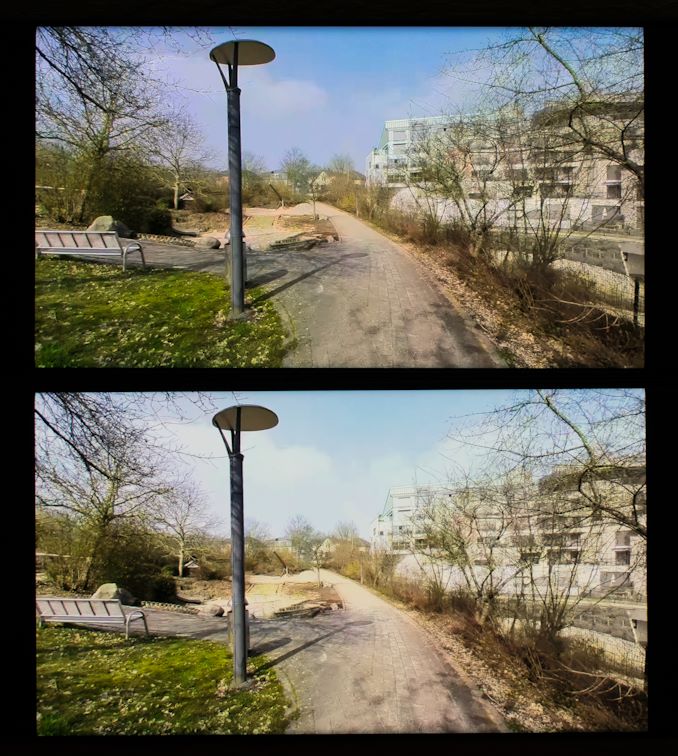
YouTube HDR - Top: (correct render) Bottom:
The above is a camera shot of both
Additionally, a 403 Forbidden’s playing back the same YouTube video. Both units reported as being in HDRboth seemingly were playing the same VP9 stream. However the unit’s rendering was evidently not correctbrightness was off. Playing the video as recorded on the unit on the native video player on the resulted in identical playback between both devices,since YouTube’s VP9 encoding seems relatively ok on the , so this might be an issue with HDR decoding VP9 on the phone.
However the issues with the format don’t end there. Using ’s own Gallery app conversion to SDR results in something akin to a bad joke. The video is mastered in far too low brightnessthe whole thing is just . We attempted a quick offline re-encode with FFMPEG,while the result was still bad, it was at least better than what the Gallery app achieved.
Currently unless the isn’t natively played back on a device, the format just isn’t compatible with anything else. Every YouTube video recording, even in HDR, is going to be off,every SDR conversion, unless more professionally done, is also going to be way off.
So for the time being, unless you want to keep your videos on-device, I would recommend not using on the
Additionally, a 403 Forbiddensticking to SDR video. This is actually a big pity as the mode does vastly improve recorded dynamic rangethe increased gamut is also very welcome. I wish had opted to go the Apple route of recording high dynamic range video yet storing it in SDR format; the iPhones currently beat the SDR result of the
Additionally, a 403 Forbidden in this regard.
As for video recording quality itself: It’s good. As with other phones, recording with the wide-angle module is a joy. It’s to be noted because the module doesn’t have you do have to have on for this mode otherwise it results in very shaky video, however because the module is such a wide angle, the cut-off margins due to aren’t as problematic. Video detail is good in all modes,the doesn’t seem to result in noticeable losses. Transitioning between modules when zooming inout is goodwith minimal delay. Audio recording quality is incredibly goodclear, has been strong in this regard for a long time.
Overall, the
Additionally, a 403 Forbidden’s main advertised video recording feature is a gigantic double-edged sword. The video quality in it is fantastic, however you will have a very hard time sharing your videos with anybody as the ecosystem just isn’t ready.
The speakers of the
Additionally, a 403 Forbidden were a big surprise for me as the company hadn’t really mentioned the improvements. With the new screen design, has also seemingly completely redesigned the earpiece speaker on the S10. In fact, it serves as a full-blown stereo speaker which is of significant higher quality than what we’ve seen on the S9.

Looking at our speaker loudness tests, we see the
Additionally, a 403 Forbidden+ perform significantly better than the S9+. What is important to note here in the results is the very small difference in loudness between holding the phone one-handed in portrait mode versus holding it two-handed with cupped palms. The only other phones who had such small deltas were the Pixel 2Pixel 3’s front-facing speakers, however the
Additionally, a 403 Forbidden goes a lot louder than both of these, without distortions if I might add. Currently the
Additionally, a 403 Forbidden is the phone with the best frontal directionality in audio playback, something I did not expect.
Looking at the frequency response of the
Additionally, a 403 Forbidden, we see that not only makes the speakers loud, but they’re also of very high quality. The S10+ has notably improved the bass, upper-mid-ranges as well as treble versus the Galaxy S9+.
The one thing I would critique on is the new volume control steps. The audio is now so loudclear, that sometimes at night I want to have it set quieter, but the issue is that the new volume controls in OneUI have a lot less discrete steps, with less finer button-pressed levels than in previous generations, requiring one to fiddle with the volume slider to get to a certain volume. This is also valid for headphone playback.
During this testing I noticed that another difference between the units is the audio quality of the DAC. The units have this reputation of being the ones with the high quality audio playback quality, but this is mostly just reputation based on these variants having Wolfon/Cirrus Logic audio chips,not actual measurements.
As such, even my own figures here will be hitting the limits of my own measurement hardware, but if we keep in mind that these are not definitive measurements of the devices, then we can have a more balanced view. In particular for the
Additionally, a 403 Forbidden, these are very indicative of what you’re to expect as a difference between the two units.
Additionally, a 403 Forbidden+
The
Additionally, a 403 Forbidden continues to showcase excellent results with what was in line with Qualcomm’s Aqstic line of DACs over the last few years: a very clean output with very little noise.
Additionally, a 403 Forbidden+
Switching over to the
Additionally, a 403 Forbidden however we’re seeing some pretty shocking results. The phone uses a Cirrus Logic CS47L93 audio codec chip which has actually been used in variants since the Galaxy S7. Unfortunately in recent years this was surpassed by Qualcomm’s audio chips,in particular the
Additionally, a 403 Forbidden suffers from a pretty bad implementation. Here we’re clearly seeing noise components that are not part of the reference 1KHz signal, with a particularly odd 250Hz component. The measurements were done in sequence with just re-plugging the input from the to the under the same conditions. Audio output level was calibrated at near -10dbV / 312.5mV RMS on both devices.
In practical terms, there is audible difference between the two as the unit sounds warmer (in a bad way)more muffled. The achieves higher claritythe sound stage appears wider. This was my subjective evaluation using the same ’s included AKG headphones on both units, both having the same software audio settings.
I applaud for still including the 3.5mm headphone jack on the
Additionally, a 403 Forbidden – however a big part of the world will unfortunately experience lesser audio quality on their model variants.
As early as last year I heard from some vendors that had big plans for the
Additionally, a 403 Forbidden, with the company aiming to make the device “something special” for its 10th year anniversary. While I believe has definitely raised the bar with the
Additionally, a 403 Forbidden, I'm left with mixed feelings on the phone overall. On the one hand it really is an almost perfect device, yet at the same time it also comes with many flaws.
The design of the new
Additionally, a 403 Forbidden family,in particular the S10+ is a stand-out feature of the new phones. In terms of aesthetics, the phone looks great with the new minimal bezels, however I think could have done better with the new cut-out camera designs. In particular, I would have liked to see the cut-out be slightly higher – placing it near the bezel of the screen – as to avoid having such a thick notification bar. Instead, this wasted space means that despite the larger screenhigher screen-to-bezel ratio, the top of the screen is no more useful on the
Additionally, a 403 Forbidden than it is on the S9. Personally, I also didn’t like the visuals of the cut-out, however Night Mode in OneUI makes this a non-issue.
Another design change I didn’t care for was the new ergonomics: because the phone’s round edges now have a tighter radius, even though the absolute width of the S10+ hasn’t changed from the S9+, it actually feels like a bigger phone. The just released Huawei P30 Pro has almost the same width as the S10+, however those 1-2mmthe wider curve gradient with smaller bezel edges makes for a significantly more comfortable device. So if you’ve used the Plus variants of the S8 or S9 in the past, I’d actually recommend trying the regular S10 first. Finally, another oddity in the design of the S10+ is that the power button is just absurdly high up, which is a definite regression in ergonomics.
The screen of the
Additionally, a 403 Forbidden is excellent, however there are still bugs in ’s factory calibration. Getting correct gamma curves seems to be a major issue for ,we’re now in the Nth iteration of a Galaxy S phone where we’re seeing problems like this. The S10+ variant in natural mode has far too lownon-linear gamma, while the unit again clips the lower greyscale levels to black. This is fundamentally a software issue,like in past years with the S8S9, will probably address it in a software update. I just wish would finally get their quality control to the point where they can get this correct for the phone's release, rather than having to fix the display settings after the fact. The screen for the third year in a row also has a too red default colour temperature.
In terms of display accuracy, does well, but it’s no Apple. ’s choice of enabling Android’s colour management system on the S10 is weird. At least does have one first-party app supporting it: the Gallery, which is more than what you can say about Google's own Pixel phones. Beyond this, the inherent limitations of the Android CMS means that it’s nowhere near as useful as how it works on Windows or even the current gold-standard: Apple's iOS. I wish that would have at least enabled wide-colour gamut support for taking photos. Maybe that’s something for next year?
Two s - This year more evenly matched
One of the bigger narratives for the Galaxy S series over the last few years were the product differences between the units.2019 in particular was a rough year for ’s in-house developed variants, as the chip simply delivered a notably worse experience than what was available on variants of the phones.
The met our expectationsinitial impressions of the new Qualcomm chip. The combination of Arm’s new Cortex- coresQualcomm’s Adreno ,the new 7nm manufacturing node make for a fierce little chip. Power efficiency in particular is fantasticthe represents be a solid foundation for many other flagships in the coming months.
Meanwhile the improves massively over its predecessor. This year, LSI has largely addressed some of the previous deal-breaking issues with the introduction of the new chip. On the microarchitecture side, the new Cheetah M4 cores don’t bring as big of an improvement as we would have wanted. ’s IP still seems to lag behind the Cortex-, however the new cluster designintroduction of Cortex- cores as the middle cores seems to have resolved the overall efficiency issues that the previous generation had.
In terms of , the chip slightly lags behind the , partly due to the microarchitecture differences, but mostly due to Qualcomm’s much more aggressive scheduler. With that said, in real-life daily usage (and thanks to better framework boosting mechanisms on the ) the differences are actually minor. So you should have a harder time telling the difference between the two, with the end-result being a similar user experience.
The most surprising result in our testing was that both variants of the S10+ seem to be almost evenly matched in terms of battery life. The variant even has a slight advantage in our web test, while the variant pulls ahead in PCMark. It should be noted that the S10+ does suffer from some firmware issues at the moment which cause higher idle power consumption, however this fundamentally can beshould be fixed by in comfing updates, as it’s inherently not a hardware issue.
In absolute terms, both
Additionally, a 403 Forbidden+ models are now ’s longest-lasting phones ever. Critically, seems to have taken hardware optimisations for battery life seriously, so the most important improvement for the S10+ isn’t its larger 4000/4100mAh battery, but rather the reduced base power consumption of the phone that is now 100-120mW below the Galaxy S9. This is the true reason the S10+ lasts so long. It’s fantastic to see focus on this aspect of battery life,sets the new bar for the rest of 2019 for other vendors to meet.
Talking about cameras, the new wide-angle sensor on the
Additionally, a 403 Forbidden is a fantastic addition,it really augments the shooting experience. Currently it ranks as the best wide-angle shooter out there, battling with the Mate 20 Pro’s wide angle unit.
As for the rest of the camera modules, while the main camerazoom module haven’t fundamentally changed much compared to the S9 in terms of specifications, the processing has changed dramatically. First of all, I applaud for keeping all three cameras for both the S10S10+ – no longer is the smaller version handicapped in the camera department.
The key new aspect of the S10’s cameras, beyond the wide angle module, is their far greater dynamic range, which looks to be significantly ahead of other phones. ’s AI processing actually makes usage of the s of the chipsets,I think one of the results is that the
Additionally, a 403 Forbidden now is now often spot-on in terms of exposure, colour-balance, as well as consistency between shots.
Additionally, a 403 Forbidden+
One surprising revelation of our testing is that there are huge (and dare I say shocking) processing differences between the S10+ variants. HDR on the unit is consistently superior, as it's able to achieve much better dynamic rangedetails in shadows. Furthermore, the unit’s colour rendition is more saturatedakin to the real-world, as opposed to the more washed-out pictures the variant produces. This difference is really accentuated on the wide-angle module shots. My unit’s wide angle camera suffered from inexplicable blurring off-centre, making me suspect that there are issues with the actual optics of that lens. If so, this is a quality assurance issue out of the factory as the module doesn’t even have an autofocus mechanism which might otherwise cause such an issue.
Low-light camera capture on the
Additionally, a 403 Forbidden+ is nothing special. Here the phones still largely lag behind Huawei’s capabilities,the new Bright Night mode that the phone comes with is also no match against Huawei's Night Mode or Google’s Night Sight. I would have liked to see more usage of computational photography to improve the phone’s capabilities, especially given that the s have the new IP blocks to enable it.
video recording is great, however it will be a pain to do anything with the resulting video files as there are big compatibility issues. Attempting to play back HDR recordings correctly on social media sites or any other non- device is a mess. Even ’s software to convert videos to SDR is currently bad or just outright missing, something I hope will be addressed with coming software updates.
Finally, another difference between the is the audio playback quality on the 3.5mm headphone jack. Unfortunately it looks like messed up with both the DAC as well as the implementation, as the
Additionally, a 403 Forbidden has widened the existing year-long disadvantage to the .
Overall, the
Additionally, a 403 Forbidden+ is an almost perfect device. At least, it would be if it weren’t for the fact that there's two of them. The
Additionally, a 403 Forbidden+ is actually the first phone I would have considered giving a gold award to, which considering that over the years I've never given an award to any phone should put things into context.
If you’re a reader in the US or other markets, you can stop reading herefeel happy about your purchase or go aheadbuy the
Additionally, a 403 Forbidden+.
Unfortunately the rest of the world gets another phone. Although battery life this year aren’t an issue for the variant, the unexpected huge discrepancies in the camera quality, some screen calibration bugs,the audio quality disparity all make this variant of the
Additionally, a 403 Forbidden+ a lesser choice. Except for the audio matter, most of these issues are software related. However I do have reservations if it’s even possible to make the camera processing equal to the .
Yet even with all these drawbacks, the variant of the
Additionally, a 403 Forbidden+ is still a great phone. It's just not as great as the version; which is to say that it's not as great as it couldshould be. Consequently, interested buyers may want to wait a few months to get it at a cheaper price, making one feel better about the disadvantages it has against the .
Ultimately if wants to continue to compete against Applea surging Huawei in the ultra-high-end smartphone space, they will need to be able to deliver more consistent products across all markets. That Mobile division is not a vertically integrated with full control over their own silicon is now starting to show its disadvantages. It’s clear that vertical integrationmore exclusive features is how things will go forward in the future for vendors who want to truly differentiate their products. In Mobile’s case, even with 's incredible resources at their disposal, if they have to split their attention across two variants, it means each model will only get half the invested effort. Which, I suppose, is food for thought for what this means for the future of ’s flagship devices.

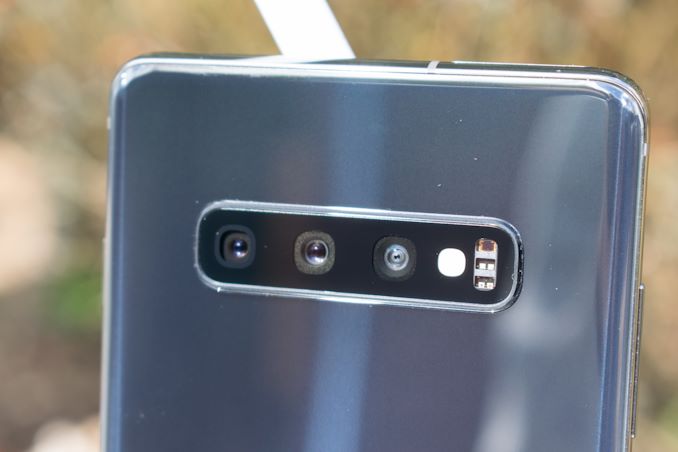
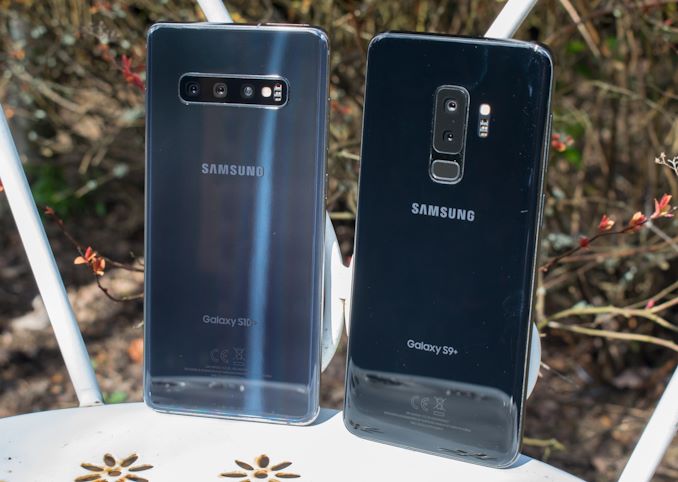

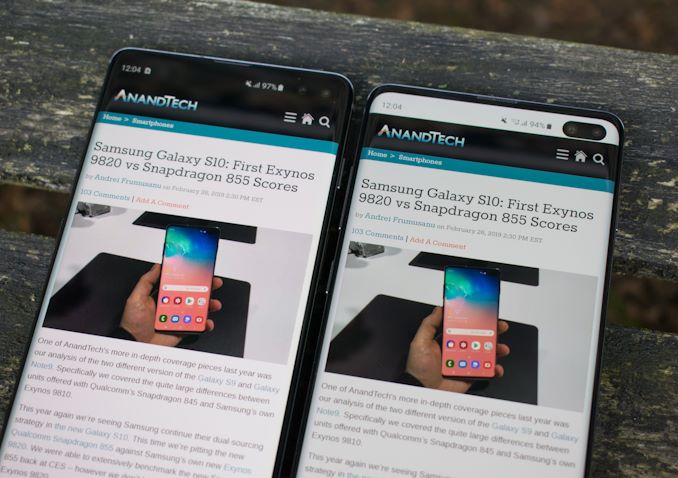
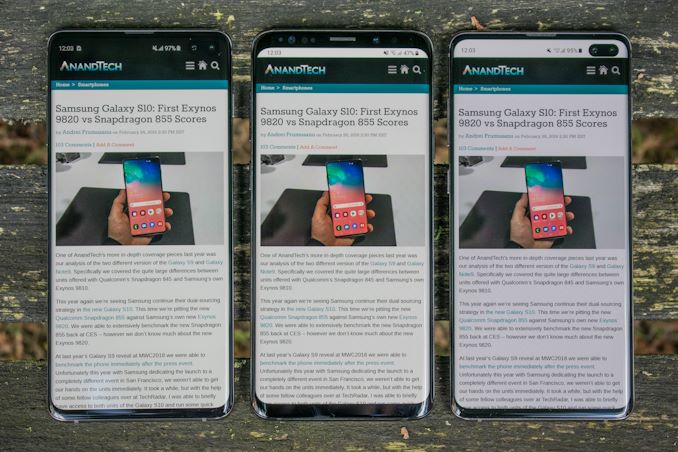
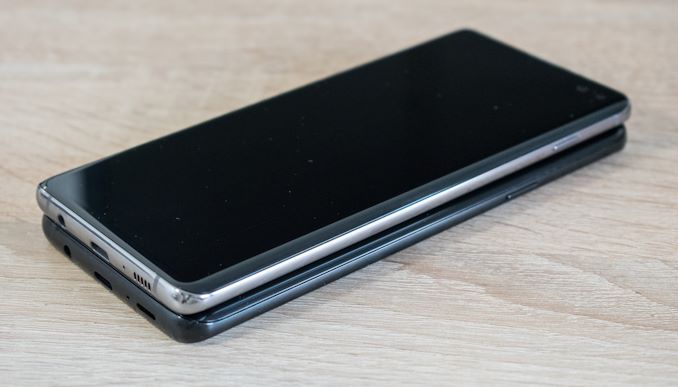




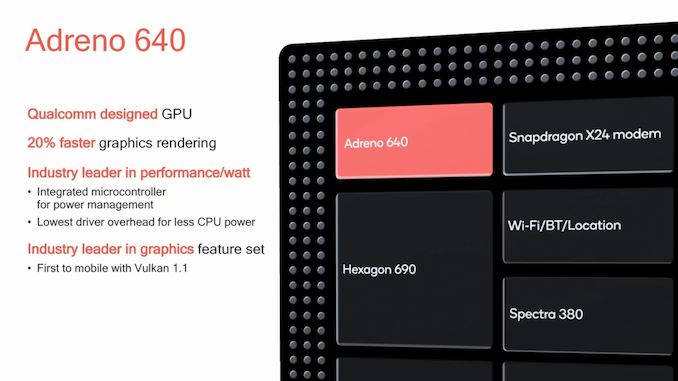
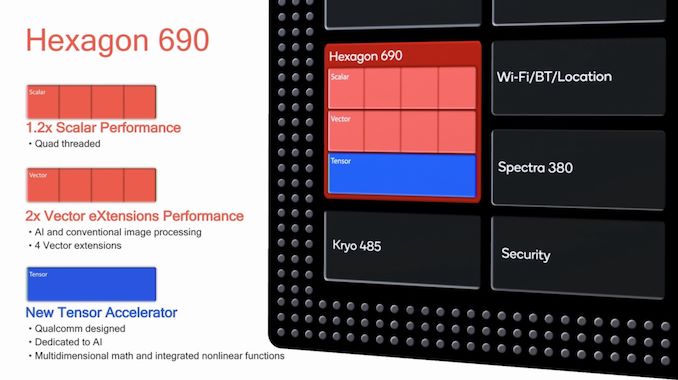
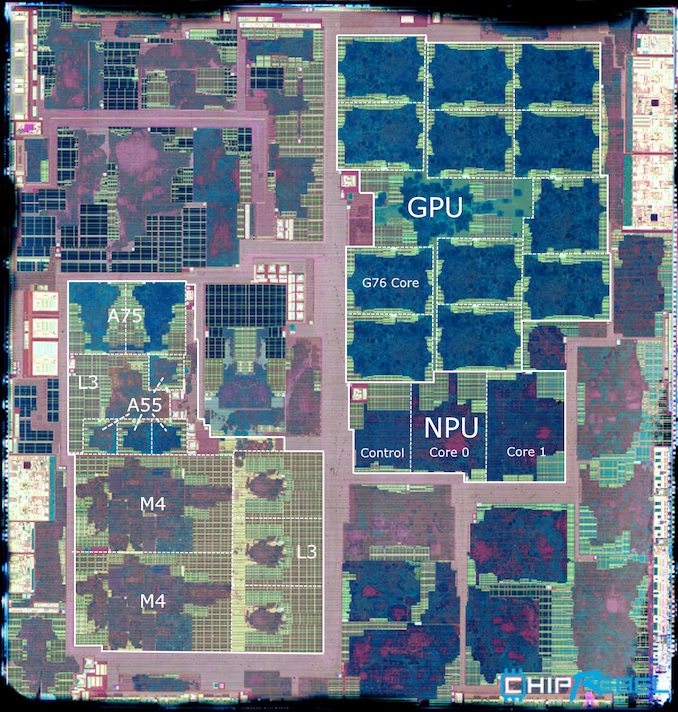















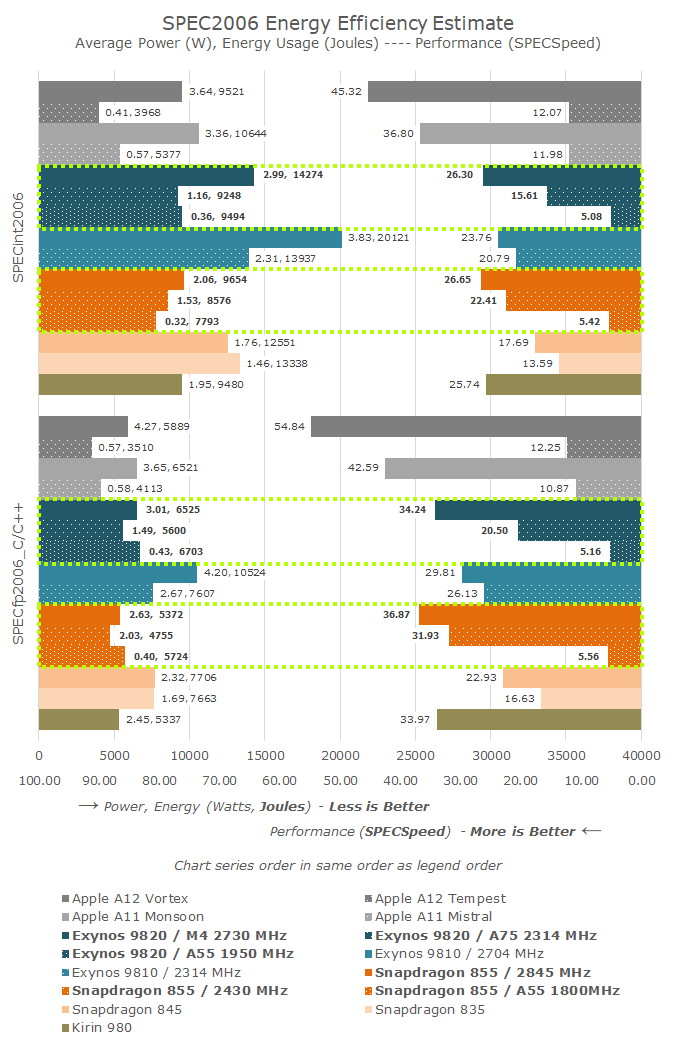
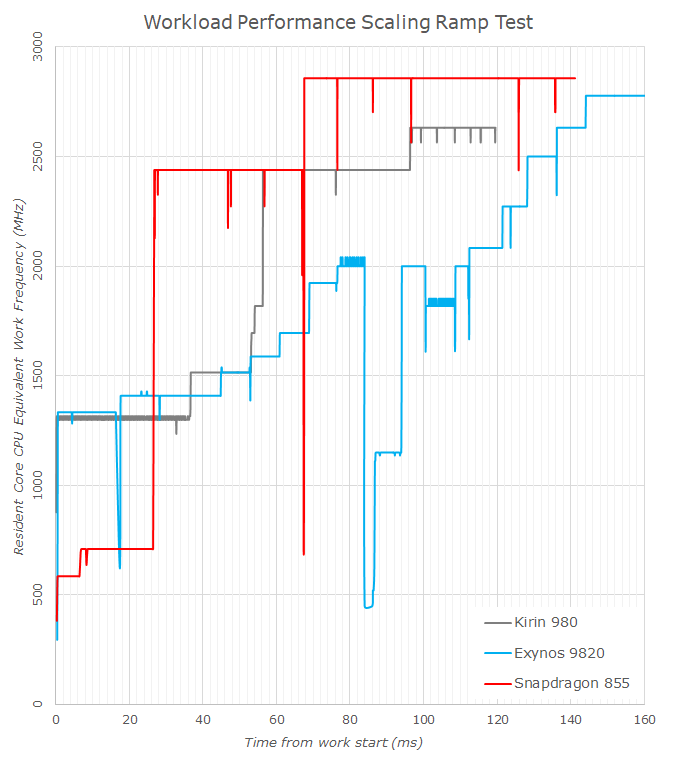
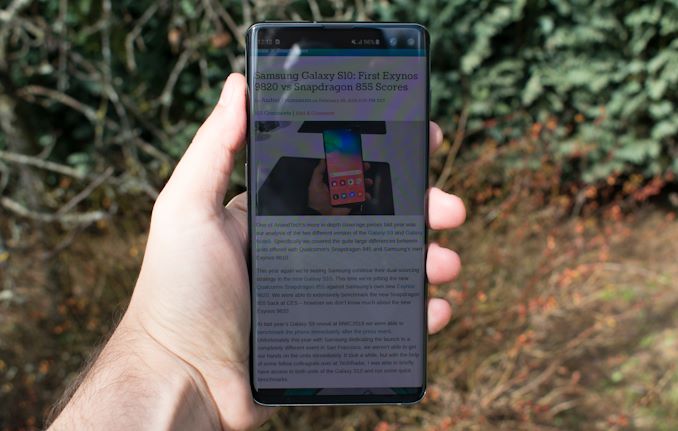

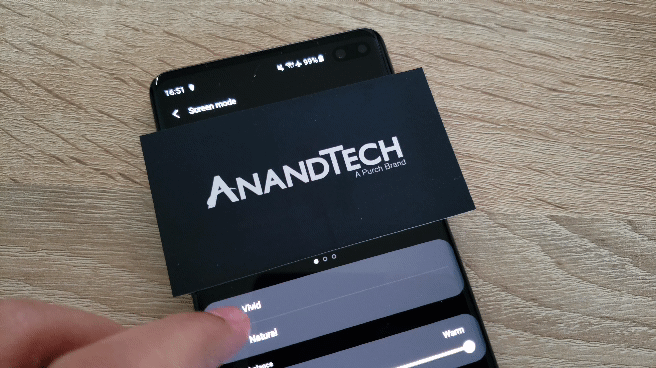




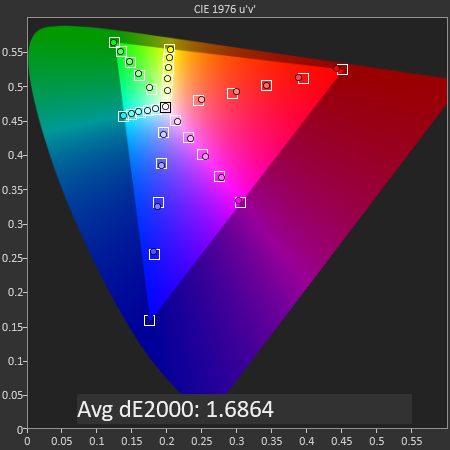

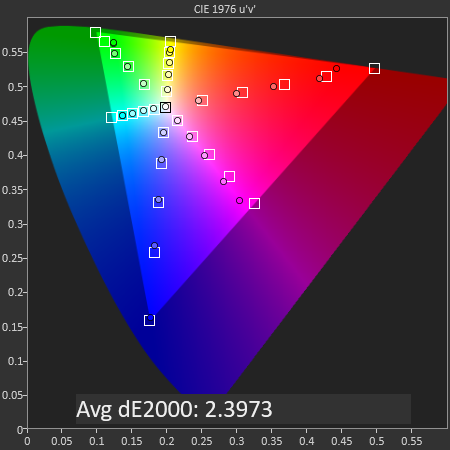
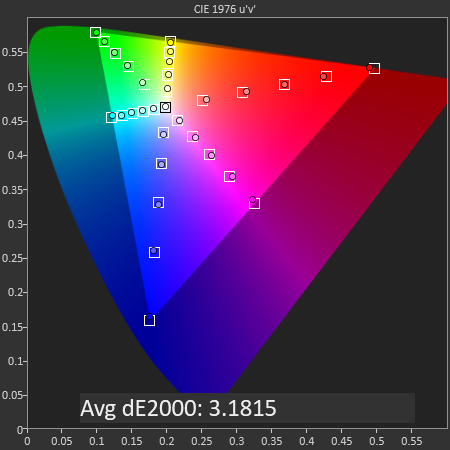



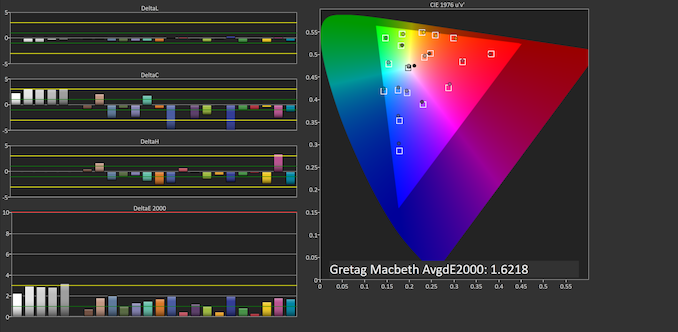



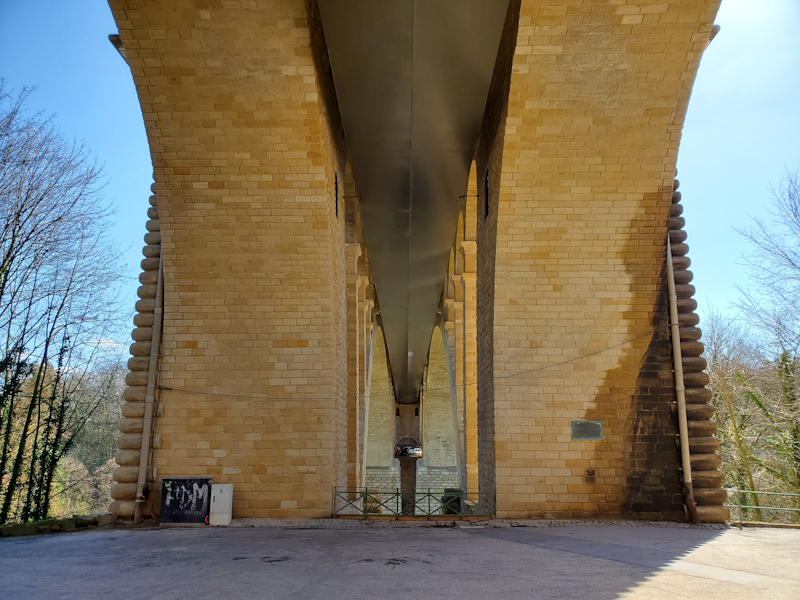
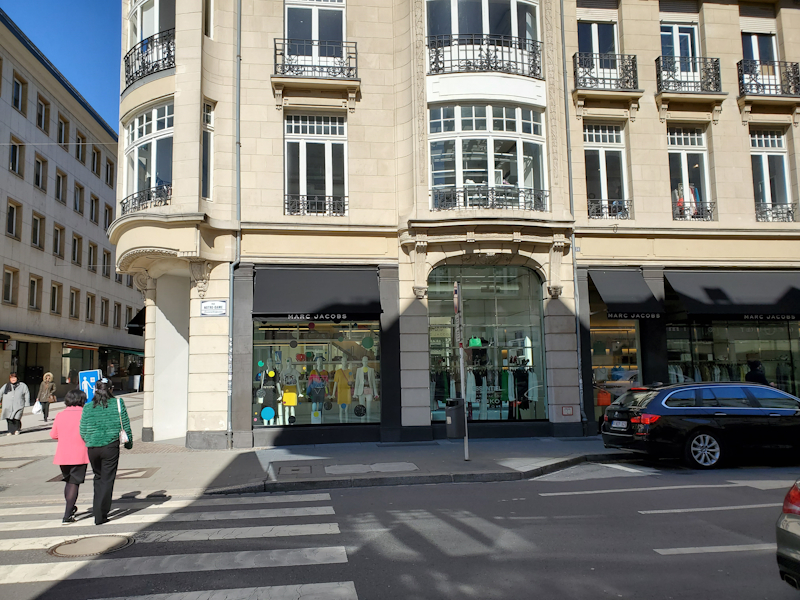



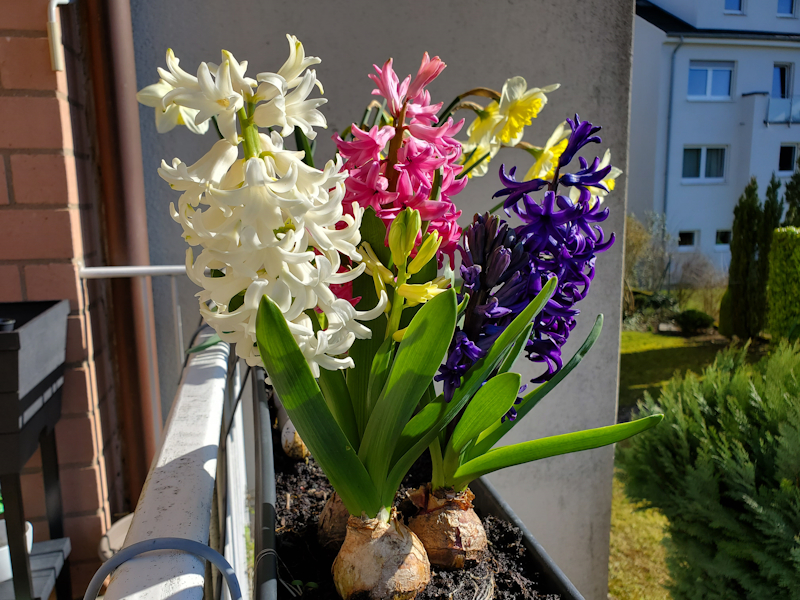
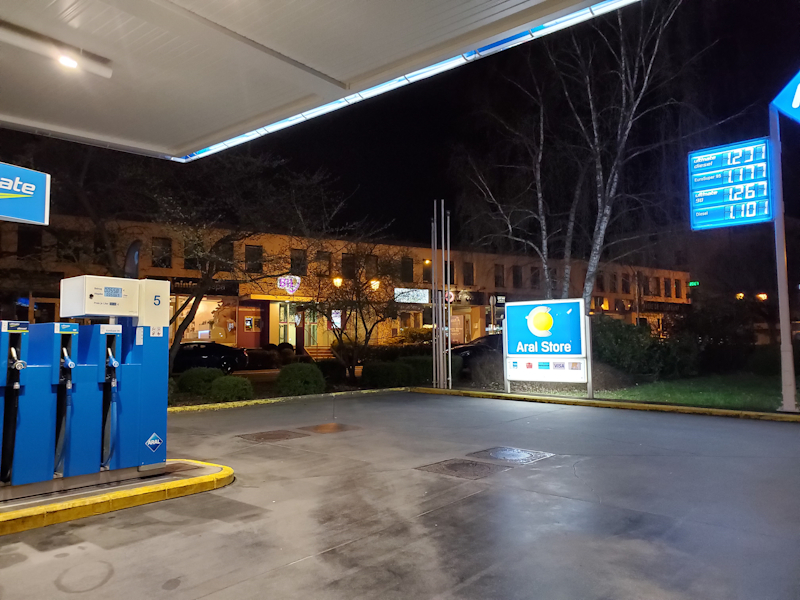

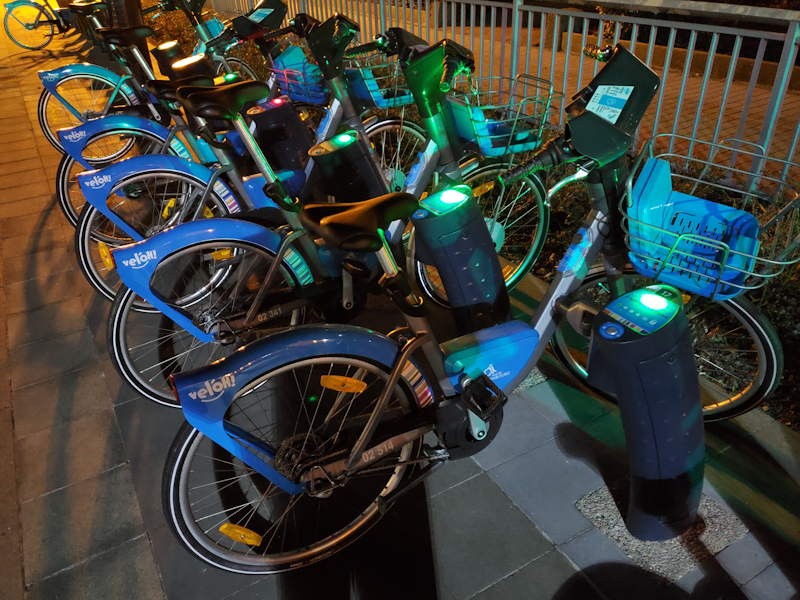
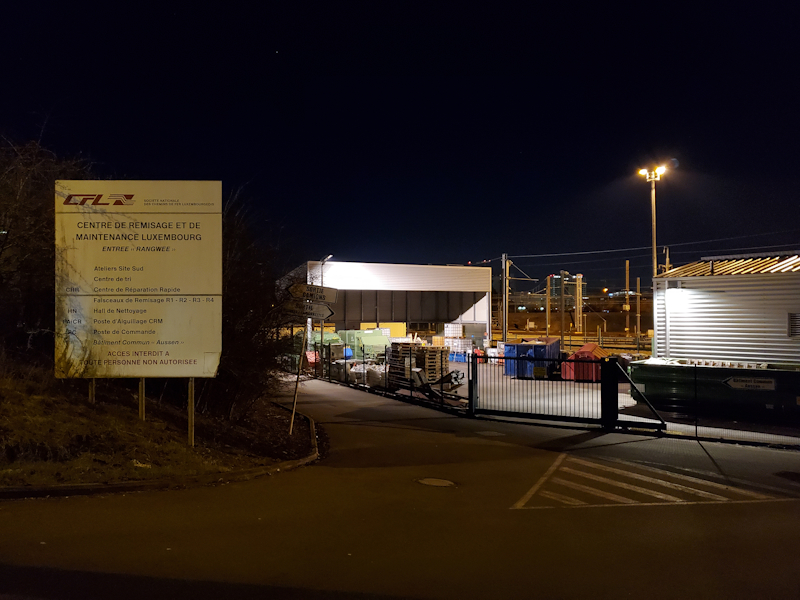
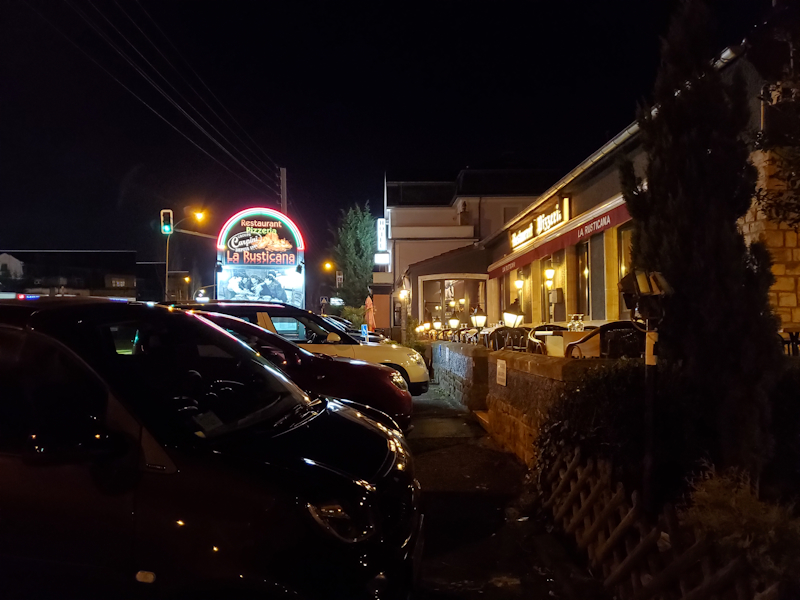


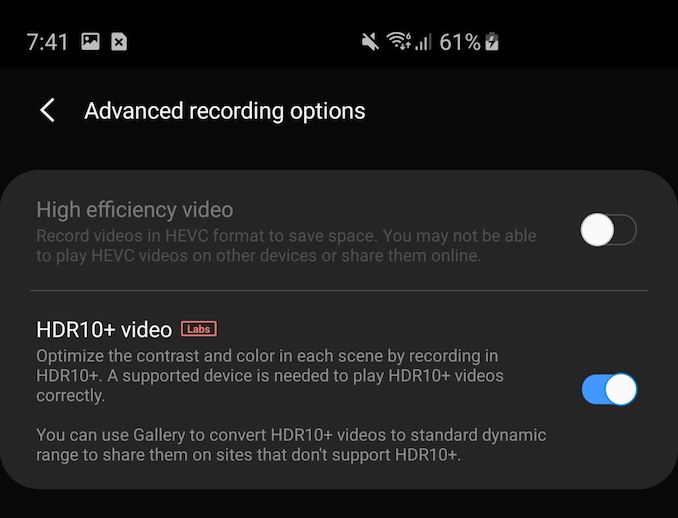
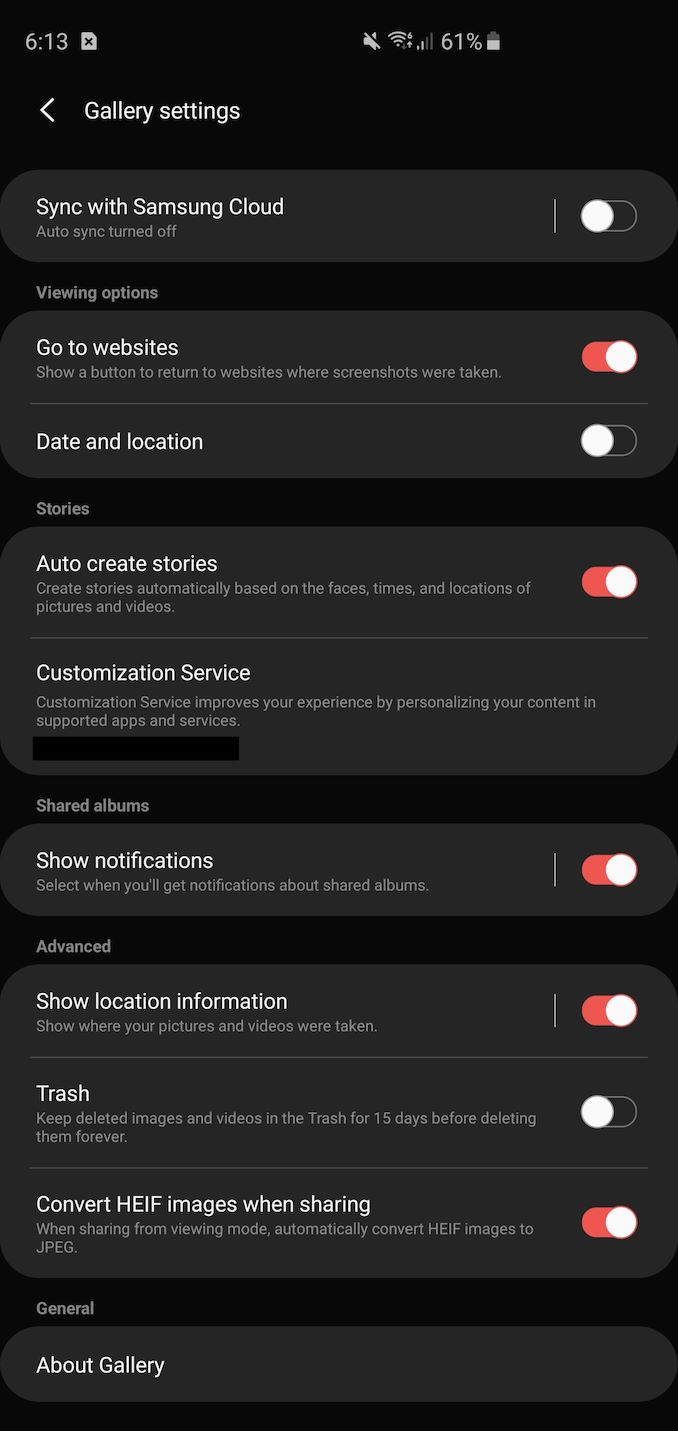
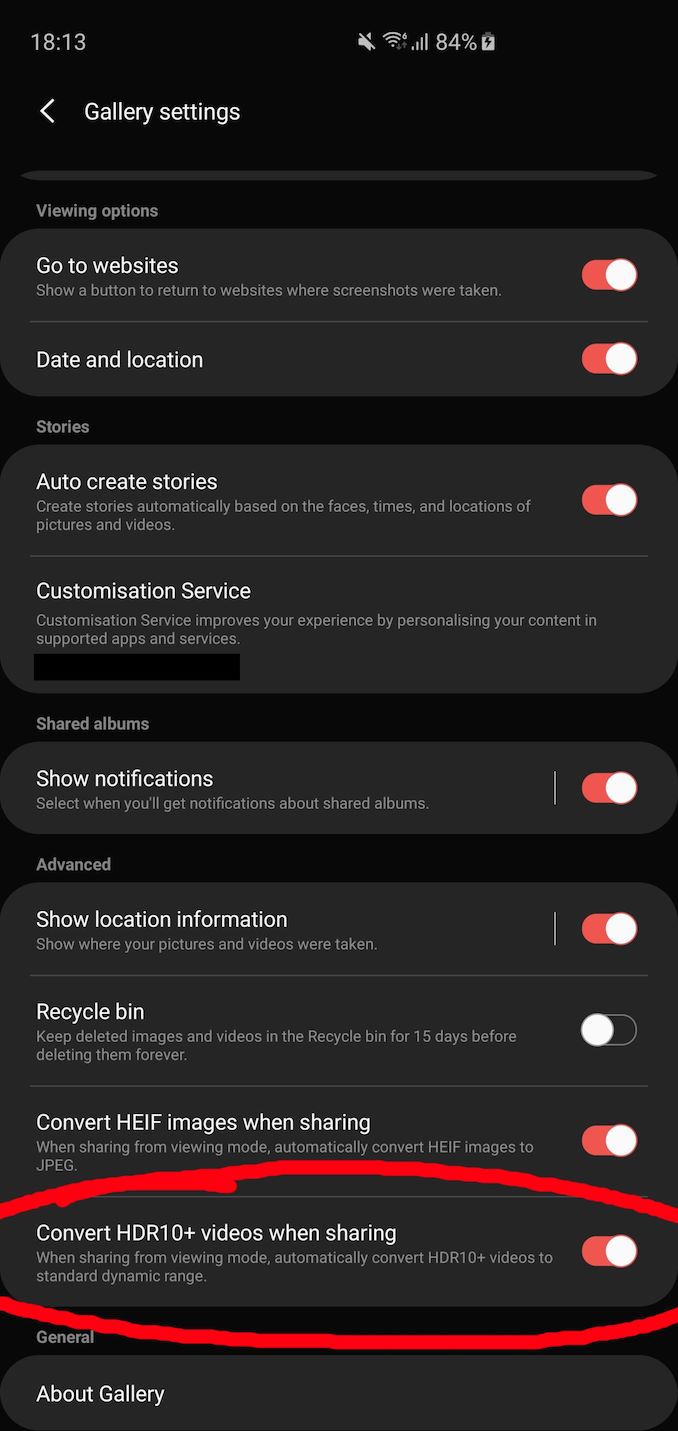
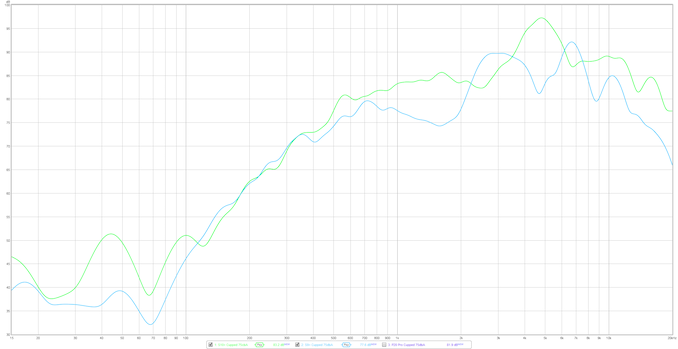

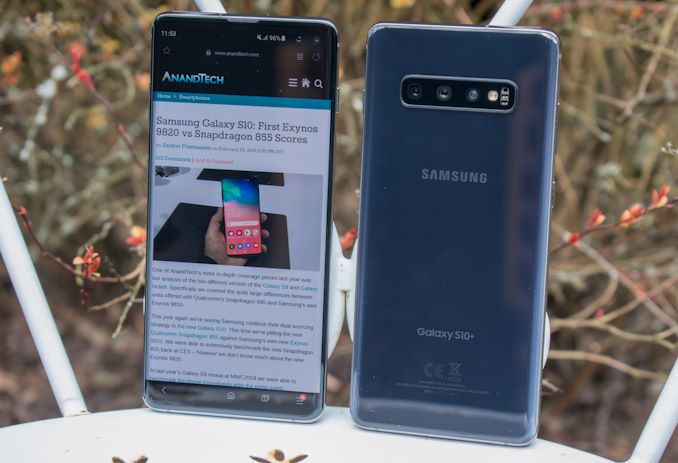

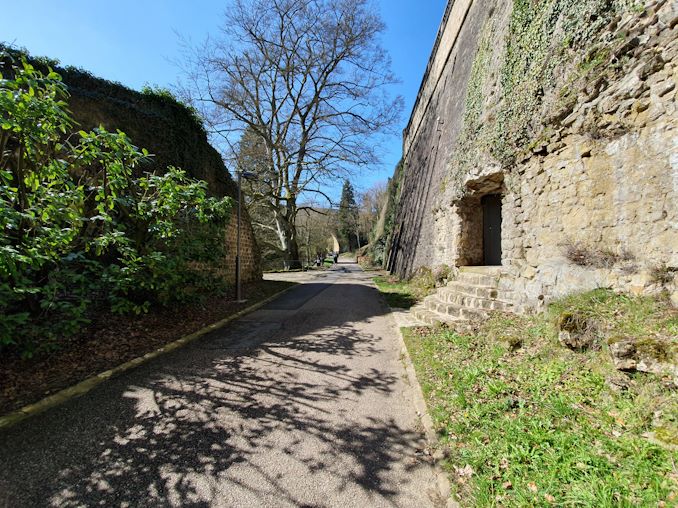
0 Response to "The Samsung Galaxy S10 Snapdragon & Exynos Review Almost Perfect Yet So Flawed AnandTech"
Post a Comment